Living on a Boat: Beginner's Guide for Liveaboards
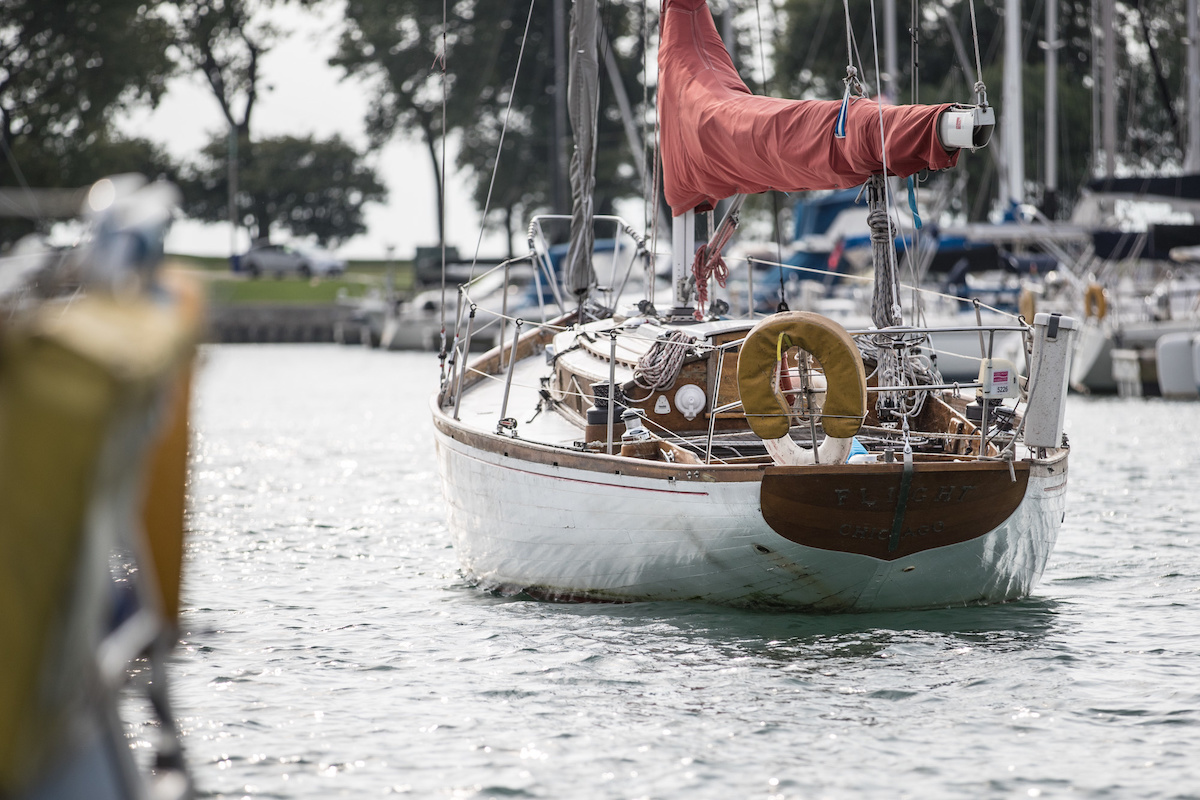
It’s easy to romanticize the idea of living on a boat full-time; however, it's an alternative lifestyle like that takes preparation, organization and an ability to roll with changes. When you commit to moving aboard, make checklists of necessities and talk to your partner about deal-breakers. Prepare the boat for life aboard well before you make the move.

Factors to Consider Before Living Aboard
Before moving onboard your boat, you should ask yourself some questions:
- Is this just for a period of time before you go cruising or is this a lifestyle choice?
- Are you comfortable with repeatedly defending your choice to your friends and family?
- Are you living in a climate that is boat-friendly year-round?
- Are you handy and a good problem solver?
- Who will accept your Amazon deliveries and are you ready to grocery shop frequently since there won’t be room to stow much?
- Are you ready to become your own maid?
- Will you feel comfortable with your kids being in this new environment?
- What’s Plan B if it doesn’t work?
After moving aboard, you may be hauling the laundry to the laundromat or groceries from the parking lot with no dock cart nearby. You’ll need to go to the pump-out station regularly as well as to the post office for your mail. Small doesn’t translate to easy so mentally run through a typical week and write down solutions to the issues.
Essentials: Stowage, Comfort & Connectivity
When you move from a 2,000-square foot house to a 40-foot boat, all the closets are smaller, the cupboards are fewer and there’s no two-car garage. In preparation, you’ll need to de-clutter kitchen gadgets, tools, mementos and clothing. Keep winter clothes in off-boat storage and your business attire at the office if possible.
Make sure the boat is warm and dry with plenty of ventilation. Mildew and condensation will become a part of life and you’ll need a whole new set of cleaners and tools.
Plan your connectivity needs. Whether a dish for TV or high-speed internet access via the marina WiFi, you’ll need a connectivity solution so you’re not cut off from work, friends, family and entertainment.
Beneficial Skills to Have for Living Onboard
Maintenance on a boat may be worse than in a house in terms of frequency and specificity. Basic plumbing, electrical and mechanical skills will be needed because boat systems are generally less reliable than their household counterparts. The alternative is calling a contractor for every issue.
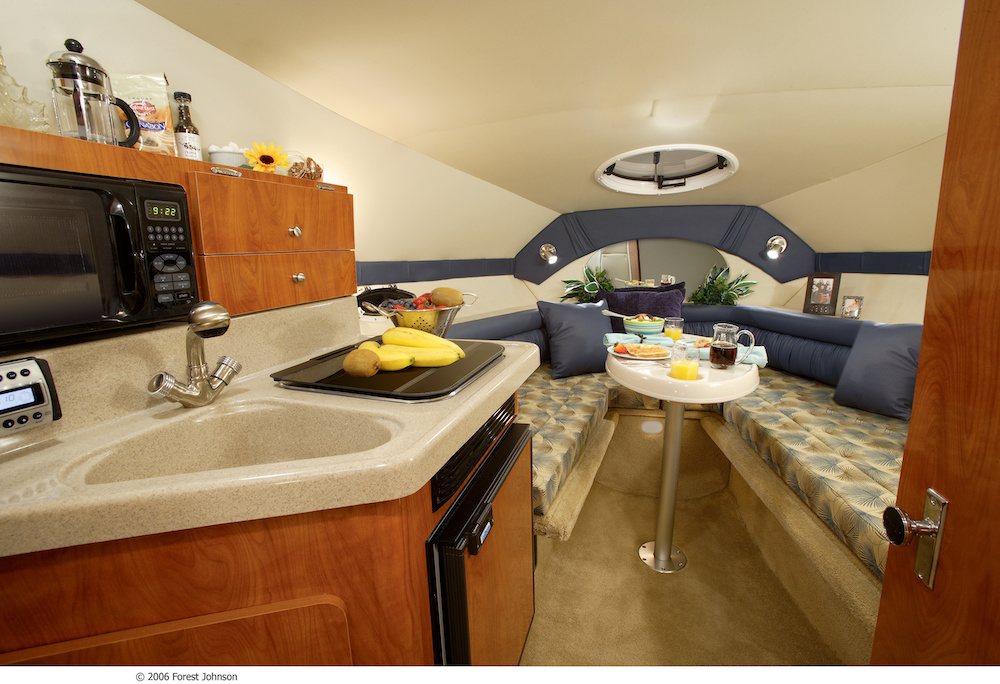
Cost of Living on a Boat
Don’t assume that you’ll save money by moving aboard. Here's some expenses you may incur by living on your boat:
- Boat mortgage payment
- Boat insurance
- Waste management
- Food and water
The best way to manage expenses is by making a budget and sticking to it. Depending on the size and value of the vessel, boat insurance may be just as expensive as house insurance. Property taxes will usually be less as will electricity since you’ll not be heating/cooling/lighting as big a space. You’ll probably save money on waste management, gas and water as well.
Where costs rise dramatically is maintenance . Marine parts and labor are usually more expensive—sometimes 20% more, than typical household counterparts. If you take on the tasks yourself and you’re self-employed, every hour you spend working on your boat is an hour you don’t make money.
Learn More in our Boat Insurance Guide
Safety & Security
You’ll need to decide whether to invite strangers inside, and if kids and pets will be safe around the docks. Install CO2 and smoke alarms and a propane sniffer, check the fire extinguishers periodically, and keep an eye on the basics like bilge and battery levels. You may also want to consider the following:
- Will you be safe walking from the parking lot to the slip at night?
- Will your nice car be okay outside the garage 24/7?
- Who will call you if your boat starts to list when you’re on vacation?
There aren’t really more or fewer safety issues, just different kinds.
Daily Life & Socialization
Socializing is easier in a marina than in a neighborhood. Neighbors help neighbors in marinas but it’s a two-way street so be ready to lend a hand when needed. If you’d rather live anonymously, consider an end tie in the forgotten corner of the marina. Although there are challenges to living on a boat, if you’re prepared, you may find it a perfect fit.
I already have a boat in a slip in a marina, so can I just move aboard?
Most marinas require an application for you to move aboard permanently. In some areas, liveaboards aren’t permitted or there are long waiting lists. Liveaboard slip fees are usually higher and your insurance rates may increase if your boat becomes your primary residence.
How do I live aboard a boat with a pet?
Dogs, cats and other pets need to acclimate to their new environments. They need exercise, private space and easy access to food and a potty. Make sure stairs and docks are safe for them and that they know how to get on the boat or dock if they fall in the water. Be careful of small spaces where they can get trapped and wires they can chew. Teach them about their new environment and be patient.
Learn more in Boating with Pets and Tips for Taking Your Dog Boating .
Read Next: Boat Owner's Guide
Looking for more information on boat ownership? Read...
- Boat Owner's Guide
- Costs of Boat Ownership
- Boat Maintenance Guide
- Insuring Your Boat
- Boat Safety Guide

Join Our Newsletter!
Get community news, buying bargains, and how-to guides at your fingertips.
Save 40% off! Join our newsletter and get 40% off right away!
Sailboat Life
Sailboat Cruising and Lifestyle Magazine.

How to Live on a Sailboat for Beginners

This is a guide for how to live on a sailboat – but be warned, if you have any desire for the liveaboard lifestyle, you might quickly become on of us! Living aboard a sailboat requires an enjoyment of water, being okay with small living, and a sense of adventure. It’s not hard to begin living on a sailboat, but a few tips can help.
Let’s consider a few basic liveaboard questions first:
Is it living on a sailboat a good idea?
Living aboard a sailboat give you freedom that you won’t find in any other lifestyle. A suburban house can not be moved from place to place. But living on a sailboat gives you the options to live anywhere – literally in any country in the world! Living aboard a sailboat offers such a unique feeling of freedom to explore that you won’t find anywhere else.
Is living on a sailboat hard?
It is tough to live on a sailboat in a place like San Francisco where everyone is trying to escape super-high rent. In resort areas, many marinas have years-long waitlists for a liveaboard slip, and these slips cost double than a regular slip. However, not all places, in fact most places are easy to liveaboard.
Are you thinking about living aboard? Well, it takes time, planning, and preparation to being living on a sailboat. Here are a few videos to help you make a few calculations.
Adjusting to Liveaboard Life
Today, Emily sits down with 3 other female friends in the harbor to chat about how they transitioned from being landlubbers to liveaboard sailors in recent years. We’ll let you in on the conversation, and 4 different perspectives (though there are MANY others in the world).
- Emily, 34, aboard Temptress – liveaboard for 5 years
- Kris, 57, aboard Sixth Girl – liveaboard for 1 year
- Meredith, 44, aboard Tla Hla – liveaboard for 3 years
- Hannah, 26, aboard Sojourner – liveaboard for 2 years
How to Afford and Start Living Aboard
Your dream is to become a liveaboard? You want to know more about sailboat life, and what it means to live on a sailboat? You want to know how to afford living on a sailboat and how to afford staying liveaboards? How it feels to daily hoist the sail and follow the wind?
Start Small, Start Now
One philosophy in getting started living aboard a sailboat is to start small, start now. That doesn’t mean you have to buy a major refit project of a sailboat. You can get started in a small 24 foot single cabin boat for less than $10,000 or a mid-size 36 foot sailboat (see video below) for less than $60,000. Or grab a 1980s fixer upper that’s 42 feet in length that costs $25,000 – but beware, a fixer upper is a major expense even when you do it yourself.
Is Living Aboard for You?
No one can answer this question except you. However, if you enjoy freedom, have a sense of adventure, and love the water, then you might enjoy living aboard a sailboat.
We hope you enjoyed this how to guide for life on a sailboat for beginners. Leave us a comment or question a below.
Share this post!
Throw in your two cents, start a discussion cancel reply, related articles.

The Voyage of the Sea Star – 35ft Sloop to Bermuda

Living Aboard a 30-36ft Sailboat: A Guide for the Curious and Adventurous

Summer Sailboat Video, Bikinis, Sails, and Fun

Saved Up For This Dream

My Cruiser Life Magazine
Living On a Boat Full Time — What to Consider Before Living Aboard
Let’s talk about real-life boat ownership and living on a boat full time. My wife and I have lived on our boat for nearly eight years, doing everything from full-time living on a boat in a marina to cruising The Islands of The Bahamas for months.
For starters, everything you’ve ever wondered about living on a boat probably doesn’t scratch the surface of everything you’ll learn. This lifestyle isn’t for everyone; for every wonderful day on the water, there’s a stressful situation or broken boat part.
So what does living on a boat full time look like? Here’s a glimpse into the world of the liveaboard.

Table of Contents
Should i live on a boat absolutely yes, here’s why (pros of living on a boat), never, in a million years, should anyone ever live on a boat (cons of living on a boat), there’s more than one way to live on a boat, there’s a steep learning curve, it’s kind of like camping, constant maintenance and cleaning, weather drama, the legalities of the live aboard life, cost of living on a boat, paths to moving aboard, living on a boat full time faqs, what are the pros and cons of living on a boat.
It is often said that there’s a wide gap between the romantic vision that many people have of the liveaboard lifestyle and the nitty-gritty reality.
Here are the pros and cons of living on a boat full time, taken from our personal experiences.
Living on a boat is sometimes even better than your most romantic vision. Dolphins frolicking while the sunsets, tropical drinks in your hands, and nothing but crystal clear water between you and the most spectacular island beach you’ve ever seen. Yes, that all happens, sometimes.
- Freedom to go where you want, when you want
- Travel as much or as little as you want
- Take your house with you as you move
- Changing scenery, waterfront property where ever you go
- Wildlife visits—seals, whales, dolphins, birds
- A friendly community of other boaters
- Learn to live more simply, with only the necessities
Everyone has good days and bad days. We’ve often described boat life as having high highs but very low lows. The peaks and valleys of boat life (crests and troughs?) are just much farther from baseline-normal.
For every dolphin, there is a broken toilet joker valve leaking sewage onto the bathroom floor.
For every idyllic island beach, there is a fouled diesel filter that needs changing.
For every smooth downwind passage, there is a sloshy, windless mess of flapping sails making everyone on board seasick.
The list could go on and on and on.
- Constant maintenance and cleaning
- Difficulty finding skilled, professional labor
- Small spaces, no storage, no privacy
- No dishwashers, washing machines, dryers (usually)
- Away from docks, you always have limited power and water
- Constant exposure to the weather
- Tax and insurance issues
Common Issues with Moving Onto a Boat
Here are some of the biggest issues we have noticed from our experiences and those around us. While everyone’s experience of living on a boat full time differs, everyone seems to have similar issues.
First, it has to be said that everyone’s experience is different. And that’s most obvious by looking at what sort of boat they choose and where they choose to live on it.
Many books have been written on the subject, and most like to divide boaters into three groups based on their budgets. There are the high-lifers who can afford to buy a new or newish boat that is large and comfortable. They can afford to live at a resort marina and likely hire professionals for most maintenance and cleaning tasks. They likely spend most of their time in marinas if they travel far.
Then there are the Goldilocks boaters—not too big, not too small—making up the “middle class” of boating. There’s a healthy mix of DIY projecting with some professional help on the big projects. They might liveaboard at a marina or travel full-time. They might live at docks, anchor, or a mix.
And then there are the budget boaters. Cheap boats are easy to come by if you’re willing to use DIY labor to fix them up. They are most likely to anchor out to minimize costs.
All these people live very different lives on their boats, but does it matter? The costs are astronomically different, but they could be visiting the same ports, seeing the same sights, and even sharing the same experiences.
What’s most amazing is how everyone perceives their liveaboard situation. I’ve been to dock parties where couples on 60′ catamarans complain that they have no personal space and must take a break from being on the boat together after a few months. Meanwhile, I know a family of five (plus two dogs) that live on a 40′ monohull with less than 1/3 the space of the catamaran. They have issues, but they’re pretty happy five years later.
(Speaking of catamarans, check out my recommendations for liveaboard catamaran options.)
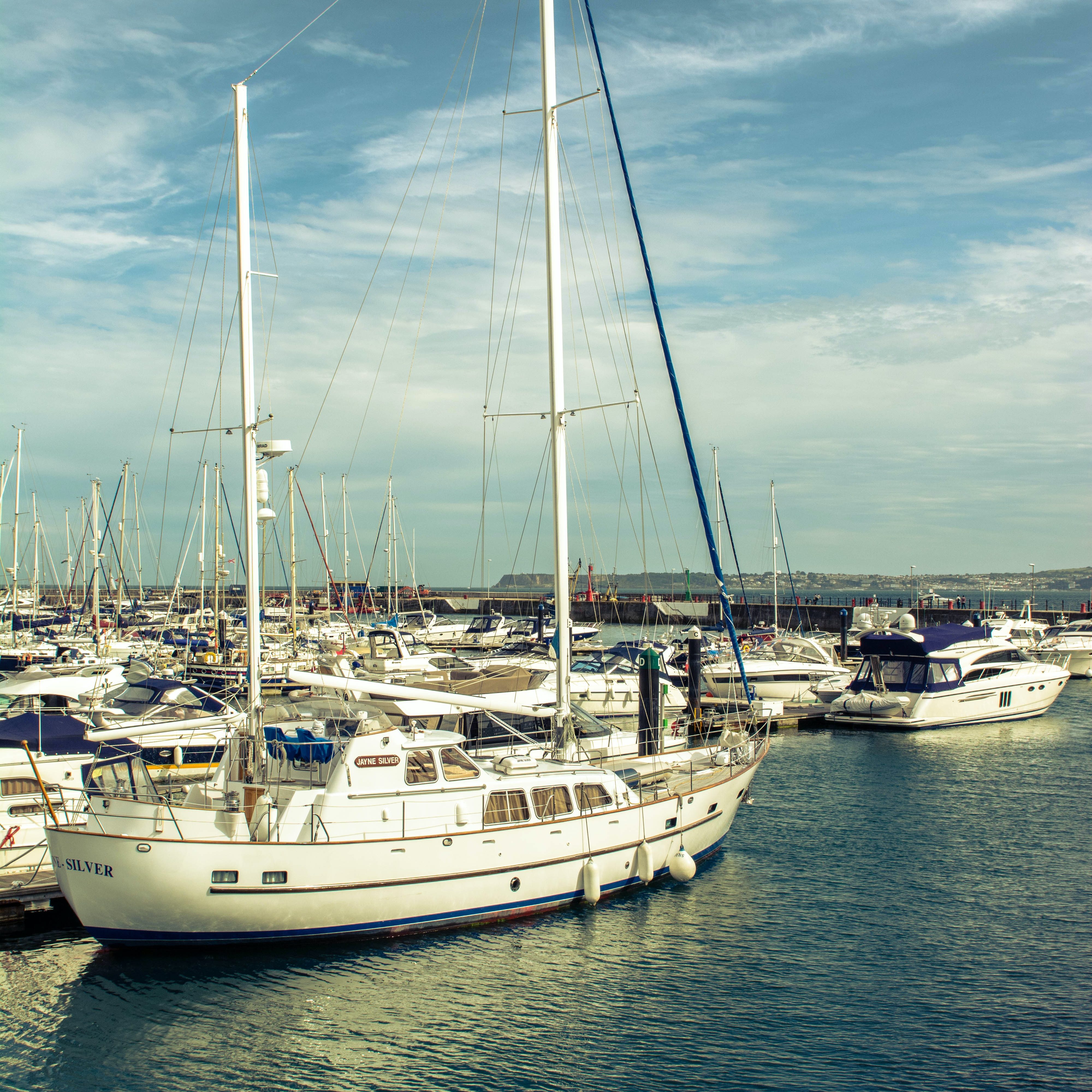
Year one of boating is the worst. There’s so much to learn; it’s all new and different than anything you’ve done before. There are all the sailing terms you must learn, but there are also boat maintenance tasks and understanding how all the systems on your boat work. Then there are the basics of seamanship and how to operate your vessel safely. It is a lot to take in.
And the basics of living on a boat are different from land life. Your kitchen (galley) is much smaller. The toilet doesn’t flush like a regular land toilet. You’re always thinking about minimizing water use when showering or doing dishes. If you turn too many electrical items on, circuit breakers pop. The list goes on and on, and when you’re new, it’s stressful.
Once you’ve got the kinks worked out, learned your boat systems, and successfully traveled and lived on your boat for a while, things get much better. You know more, your boat is set up the way you need it, and you have the confidence to start enjoying yourself. Some people take a few months, some a year, and, unfortunately, some never get there.
Boats are small spaces, but the truth is that living on a boat is more like camping than most boaters like to admit. You get by with only a few items in your wardrobe. You skip showers since you don’t always have hot water. You don’t have space for all the luxuries of home. No dishwasher. No washing machine. Everyone is occasionally uncomfortable onboard, whether from the weather or the cramped quarters.
Boats are also hard on relationships. While there’s something romantic about being cozy and alone together at sea, it isn’t so romantic on day five, or thirty, or sixty. Personal space is non-existent on most boats. It’s inevitable that your significant other—or anyone else—will drive you nuts after some time. Boats have ended more than one marriage that we know of.
The cramped living space on a boat poses other problems, too. Downsizing is important because you simply can’t bring it all with you—there’s no storage space. What is important, what’s nice to have, and what will you use on a boat? Living on a boat forces you to live with the minimum and acknowledge what you need to survive.
Living on a sailboat is, of course, drastically different than living on a luxury yacht. But all these problems seem relative, and no matter what size your boat is, everyone has the same complaints.
Boats are always trying to sink and fall apart. The ocean helps them with its corrosive saltwater and constant motion. The only thing keeping it afloat? You, the lowly and unprepared new boat owner. Yikes!
Even if you have mechanics and boatyard workers do most of the big projects for you, there’s still a ton that you’ll wind up doing on your own. Just day-to-day cleaning on a boat is a big deal. Everything is more difficult and takes longer than it does on a house.
Somehow, boats seem to get dirtier faster than houses do. From polishing the hull, shining the stainless, varnishing the teak, and scrubbing the scum line to everyday things like dishes, sweeping the floors, and cleaning the bathroom, boats are dirty, and it takes time to keep them clean.
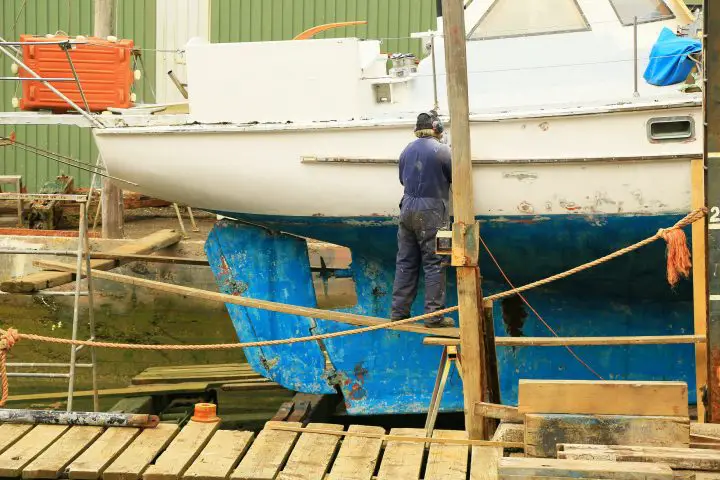
The weather plays a bigger part in your life than you’ll even imagine. Most of us pay remarkably little attention to the weather when we’re on land. If it’s hot, we might just minimize our time away from air conditioning. If it’s raining, it’s a minor inconvenience. We never think about the wind or tides.
But everything on a boat revolves around the weather. Every day we look at the weather for the upcoming week. Forecasts are often inaccurate, so we expect it to change. But what should we be ready for? When cruising, we often track weather systems over a week away and start planning.
This week, it says we might get gusts to 52 knots (!!!) from the southwest with heavy rain and thunderstorms. We’re anchored and away from the dock. Will our anchorage be protected from winds like that? Is the holding good here, or is there a safer place we should move to? Should we think about moving there early in case it fills up with boats?
We go through this exercise every week or two, no matter where we are. When approaching an anchorage, it’s all about the wind direction, tide level, and whatever else is happening. Are we okay with being stuck here for a few days if it’s foggy? A week? What if we need south winds to reach our next destination, but the forecast only has east winds? Do we wait or change our destination?
The amount of attention it takes and the flexibility of your schedule is mind-boggling to most landlubbers. When friends want to visit us, we tell them we can meet them in a specific place or at a specific time, but not both. If you want us to meet you, you’ve got to be flexible too!
What do you legally need to do to live on a boat full time? Most people’s home or apartment is their legal residence and domicile. It’s listed on their driver’s license, and it’s where they vote and pay taxes.
How will all these issues play out when you move onto a boat that moves around? There are mail forwarding services that allow you to set up residency. We use St. Brendan’s Isle in Florida since we were already Floridians, but there are also similar services in other states. This at least gives you the ability to have a driver’s license and vote.
Taxes are a little more complicated. You can register the boat at your address in Florida, but each US state collects its own use tax. If you use your boat in their state for over a few months, they want to tax it. It’s not a problem if you move around, but what if you want to leave your boat in New York for the summer? Then you might have to register it there and pay taxes.
Additionally, many counties in the US collect personal property tax on boats. We know of several places where if you are in the county on January 1 st , you’ll owe the county property tax. If you were one county away where the tax happens to be zero, you would owe nothing. Tricky!
Recreational boat insurance is another matter of concern. It used to be fairly easy to insure a boat, especially a cheap old boat. If you have a homeowner’s policy, you can easily add the boat. But if you’re a liveaboard with no real land address, getting insurance is becoming a problem. If the boat is too old, you’re traveling to distant ports, or the boat is very large, and you’re first time boat owners, it can be hard to find an underwriter.
Do you even need insurance? Many marinas and boatyards now require it. Gone are the days when you could sail the world and “self-insure.” But, honestly, those days never really existed. If your uninsured $5,000 sailboat drags anchor and puts a gash in a $5 million yacht, a serious legal headache will follow. Many owners of older vessels keep “liability-only” insurance, but even this is getting less affordable and hard to come by.
Many folks who want to try boat life are understandably curious about the average cost of owning and buying a liveaboard sailboat . Is it cheaper to live on a boat than a house? That’s a tough question to answer. For one thing, people’s expectations and their needs for comfort and security vary widely.
Both houses and boats can be found for about the same amount. If you’re in the market for a $250,000 house, you could find a nice boat for that amount. It would, of course, be much smaller and—unlike the house—be a terrible investment. So while you might be able to get a loan for a house (which makes excellent collateral for the bank), getting a loan for a boat would require a bigger risk on the part of the bank and therefore cost you a lot more.
On the cheaper end, you could find a fixer-upper boat on Craigslist or Facebook Marketplace for far less than a neglected house. A house will always have some value based on the land, whereas a boat can become valueless. It’s not uncommon to hear of people getting free boats abandoned in boatyards, making ridiculously low offers on neglected vessels, and getting large boats for a few thousand dollars. People are always wondering how to get rid of an old boat .
These fixer-uppers have their own stories, of course. Many YouTube channels are dedicated to the cheap boat fix-up scheme. Project boats can be wallet-shrinking and soul-sucking. Taking on a project is a good way to lose a lot of money, along with years of your life and any interest you ever had in boating. Project boats are not for most people.
Both boats and houses have taxes and insurance, so those costs are probably very similar. Tax laws vary by state and county. In some places, you won’t have to pay any tax on your boat except for the initial sales tax at the time of purchase. You will have to pay an annual personal property tax in other locales.
You’ll also have to pay for boat parking . Marina, mooring ball, or in the boatyard—all will come with a monthly bill. The house or apartment will not have storage fees, so there’s no equivalent here. But, if you bought a cheap boat for cash and are only paying monthly liveaboard slip fees, this might be less than a mortgage payment would be.
If you’re traveling and anchoring, you can generally do that for free. However, most cruisers spend a few nights a month at marinas. That averages about the same amount they’d pay for monthly dockage since nightly transient rates are high.
Both boats and houses have maintenance and upkeep expenses, but boats generally have more. It’s generally estimated that you should budget ten percent of the boat’s purchase price for annual maintenance. If you bought a $50,000 boat, this would be $5,000 yearly. That holds for most boats, but year one will be higher as you fix neglected items and make your upgrades.
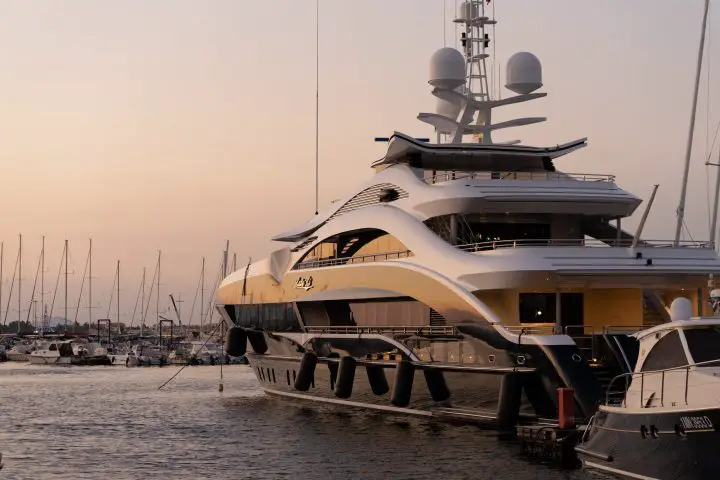
From our experience, we’ve seen people take two paths towards the liveaboard life.
- Some folks own their boat and use it for weekends or a week’s vacation here and there. They move aboard full-time as they transition to retirement, a work sabbatical, or remote work. Since it’s a gradual transition, these folks generally know what to expect.
- Then there are the folks who go all in—they know nothing about sailing or boats and sell it all and move aboard. For them, it’s a jump into icy cold water or learning a new language by moving abroad.
Which group is more successful? Group One generally knows what to expect, has worked out the kinks in their boat, and has already tackled the learning curve. There’s still a lot to take in, but they’re generally less stressed by it. If you can spend some time on your boat enjoying boating before moving onboard, it’s generally a good thing.
But, either way, being a full-time liveaboard is not a long-term lifestyle for most people. People who start from both groups seem to last an average of about one and a half to three years. After that, they’re ready to either sell the boat and move on or buy an RV or vacation land home that allows them to divide their time between boating and something else. People who last more than three years with only a boat are a very small minority.
One parting thought: Living on a boat full time and traveling is like having three or four full-time jobs. Each requires 30-40 hours per week when you include labor, research, and thinking and planning.
- Boat ownership — basic maintenance and cleaning
- Cruising full-time — destination and route planning, weather study
- Living aboard — cooking, cleaning, shopping, and everything else takes so much longer on a boat than in a house
- Your actual job — if you work aboard
How much does it cost to live full time on a yacht?
A lot depends on the size of the yacht. A small sailboat can be found fairly cheaply. For around $50,000US, you can get an older 35-foot sailboat in decent condition and move aboard with few problems. The biggest issue is finding a marina that allows live-aboard boaters. Slip fees will be your biggest expense and can be as high as $1,500 monthly in some areas. However, you can get monthly slips for as little as $300 in other places.
How to stay organized on a sailboat?
Sailboats have small spaces and not much storage, so keeping organized is key. The first step is to downsize your possessions to the bare minimum—only take what you absolutely need. The less you have, the easier your life aboard will be.
After that, it’s a matter of packing the boat so that everything has its place. Some boaters like to keep a spreadsheet of where they’ve packed everything away so they can find it quickly.
Is it cheaper to live in an RV or a boat?
Both of these activities are very dependent on location. Purchasing either one is very similar in cost. RV parks and marinas charge similar prices, but the cost varies depending on the location and services. In the end, however, moving an RV somewhere cheaper is easier and quicker, so you can live somewhere cheaply more easily.
Matt has been boating around Florida for over 25 years in everything from small powerboats to large cruising catamarans. He currently lives aboard a 38-foot Cabo Rico sailboat with his wife Lucy and adventure dog Chelsea. Together, they cruise between winters in The Bahamas and summers in the Chesapeake Bay.
Leave a comment
Your email address will not be published. Required fields are marked *
Save my name, email, and website in this browser for the next time I comment.
- Pontoon Boats
- Personal Watercraft
- nauticalknowhow
- Nautical Knots
- Tools and Calculators
5 Best LiveAboard Sailboats – Plus 8 Important Buying Considerations
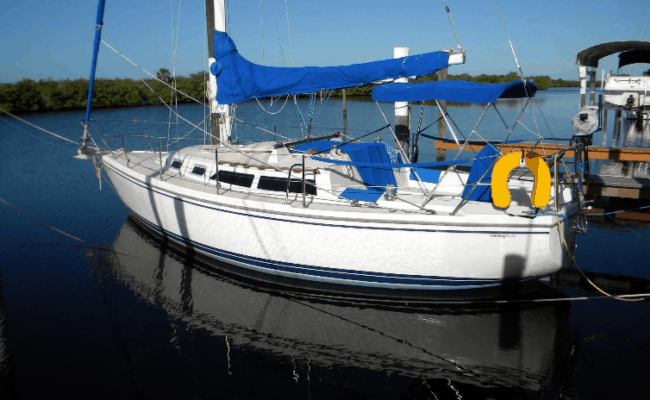
CATALINA 30
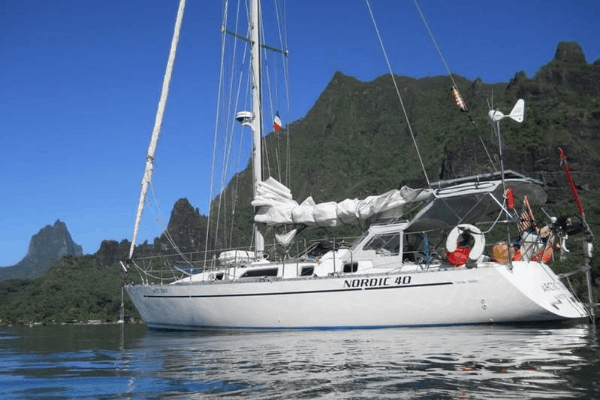
Taking the plunge to live on a sailboat is usually a huge decision, especially as living aboard a boat is an exciting lifestyle choice. However, there are lots of things to consider before buying a boat that will suit your needs and also be nearly as comfortable as a traditional home on land.
Whether this is your first time choosing a liveaboard sailboat, or you want to upgrade to a better option, you will find useful information in this article. But before we get into the best liveaboard sailboats and how to choose one, let’s see why living aboard a boat is a great lifestyle choice.
We’ve reviewed some of the best liveaboard sailboats and listed them here to help you choose one that will suit you most.
5 Best LiveAboard Sailboats
Islander 36.
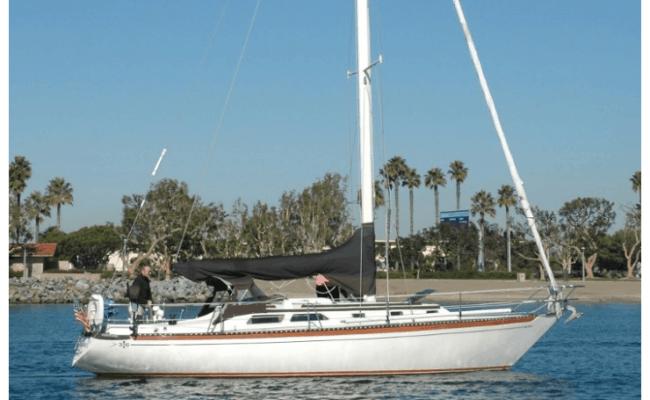
The Islander 36 is the boat for you if you want a well-rounded sailboat with impressive cruising abilities. With close to a thousand of these boats built between 1973 and 1986, the model is one of the successful and best-selling boats of the company.
These sailboats are renowned for their well-adorned cabins, with many featuring exquisite wooden interior trim. Typically, the interiors are spacious and feature a long port and starboard settee. The settee is designed to fold out into a double berth for sleeping. There is also a nav station to port with a quarter berth at the back that forms an extra seat. The boat also has a spacious master berth with an enclosed shower, making this boat one of the best liveaboard sailboats for cruising.
The interior also features plenty of drawers, plus many caned and louvered lockers. The L-shaped galley is to starboard and equipped with an icebox (that can be upgraded to a refrigerator). It also comes with a three burner LPG stove and a double sink.
Perhaps the most eye-catching feature of the interior is the companionway steps that are easy to maneuver. This is by far better than having ladders, as the steps can serve as additional separate seats when you have guests onboard.
The amount of fuel the boat’s tank can take is ideal for coastal cruising. Although Islander 36s can embark on extended trips, you will need to get additional jerry cans for that purpose.
You can check here for pricing and listings .
- LOA: 36 ft
- Beam: 11 ft 2 in
- Ballast: 5450 lbs
- Displacement: 13,450 lbs
- Sail Area: 612 sq ft
- Fuel Tank: 30 gallons
- Water Tank: 56 gallons
Boats →
If you are looking for a boat that is tough to beat feature-for-feature and size-for-size, perhaps this model will be of interest to you. Designed for comfort and performance, the Catalina 30 is arguably the most common production cruising sailboat to ever grace the open waters. Despite coming into the market as far back as 1972, their popularity to date is a glaring proof of high performance.
You can expect to find spacious accommodation in this 30-foot sailboat with modern features such as a fully equipped galley and electric pumps that supply running water. The layout features a “suite” style with a V-berth master bedroom that is closed off from the rest of the cabin.
The Catalina 30 also features a dinette that can also serve as a workspace or chart table. The boat also includes an enclosed shower and head, which makes living aboard a comfortable experience.
Check out listings for Catalina 30 here .
- LOA: 29 ft 11 in
- Beam: 10 ft 10 in
- Ballast: 100 lbs
- Displacement: 10,200 lbs
- Sail Area: 446 sq ft
- Shoal Draft: 4 ft 4 in
- Head Room: 6 ft 3 in
Yachtworld →
Weatherly, comfortable, spacious, and fast – these are what readily comes to mind when you think of the Nordic 40 .
This large sailboat is perfect for long-distance voyages, so if you intend to buy a boat that will offer excellent accommodation for offshore cruising, you know where to look. Thanks to its large structure, the interior is extremely spacious, making it the perfect choice for couples who want to spend more time aboard a boat.
The standard Nordic comes with top-notch equipment, including a Navtec hydraulic vang and Navtec rod rigging, plus full hull insulation in the entire interior. There is standing headroom available throughout, along with a spacious master bedroom.
The galley is fully equipped with modern facilities and allows for comfortable living. With the standard Nordic 40, there is no worry about storage space. Remote living is a walk in the park with this boat, even if you intend to anchor out for a couple of months at a stretch with enough supplies and provisions.
Keep in mind that these boats are not very common, but if it is the type that appeals to you, it is worth searching out.
Check out listings for Nordic 40 here .
- LOA: 39 ft 9 in
- Beam: 12 ft 5 in
- Ballast: 7,091 lbs
- Displacement: 18,000 lbs
- Sail Area: 756 sq ft
- Water Tank: 120 gallons
- Fuel Tank: 56 gallons
Thinking about taking your entire family for a coastal cruise or even a near-offshore cruising experience? Consider the Hunter 33 , one of the best liveaboard sailboats equipped for such purposes.
One of the longest-lived boats in its category, the Hunter 33 came into the market in 1977 and is still in production to date. The mid-sized sailboat comes with great interior accommodations, with ample room for sleeping and sitting. It comes with two private cabins, which is great for a 33-foot sailboat.
It features a shower and toilet aft the master bedroom. Plus, there is a full dinette and standing headroom throughout the cabin.
In a nutshell, this the perfect sailboat for those moving up in size and want a great boat with modern conveniences for an extended cruising period.
Check here for detailed listing and pricing .
- LOA: 33 ft 6 in
- Beam: 11 ft 6 in
- Ballast: 3,579 lbs
- Displacement: 11,016 lbs
- Sail Area: 625 sq ft
- Water Tank: 50 gallons
- Fuel Tank: 25 gallons
- Headroom: 6 ft 4 in
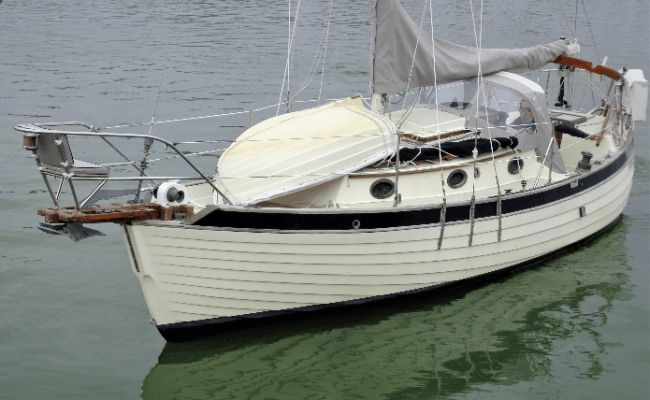
The Nor’Sea 27 is an excellent choice if you are single or searching for the best liveaboard sailboats for minimalists. This boat is arguably the best compact liveaboard cruiser available in the market today.
The compact boat has a surprisingly spacious interior for a 27-footer. Plus, it features almost every amenity you can find on a larger boat.
For comfort, the small sailboat feels more like a Catalina 30 and comes with a galley, shower, toilet, and two bunks below the cockpit. The forward berth also serves as a dinette.
The design of the sailboat is a huge success and has found a pretty strong following, which explains why it is still in production to date despite hitting the market long ago in 1976. As expected, the little sailboat costs less in slip fees. But the best part is that you can tow it on a trailer, and that’s all legal.
Don’t be fooled by its size, though. The Nor’Sea 27 isn’t cheap. Prices for new ones start from around $150K (with kits starting anywhere from $35K). You find used ones for as little as $15,500 or as much as $95,000 depending on age, quality of finish, and condition.
Find out current listings and prices here.
- Ballast: 3,100 lbs
- Displacement: 8,100 lbs
- Water Tank: 20 gallons
- Fuel Tank: 20 gallons
How to Choose the Best LiveAboard Sailboats – Buying Guide
There are several things to consider when choosing a liveaboard sailboat, but perhaps the most important factor is the level of accommodation that will suit your need. A boat with useful features such as a fully functional kitchen or electric toilets are well and fine, but many traditional sailors don’t really care about limited amenities. Any stripped-down sailboat with basic interior would do just fine.
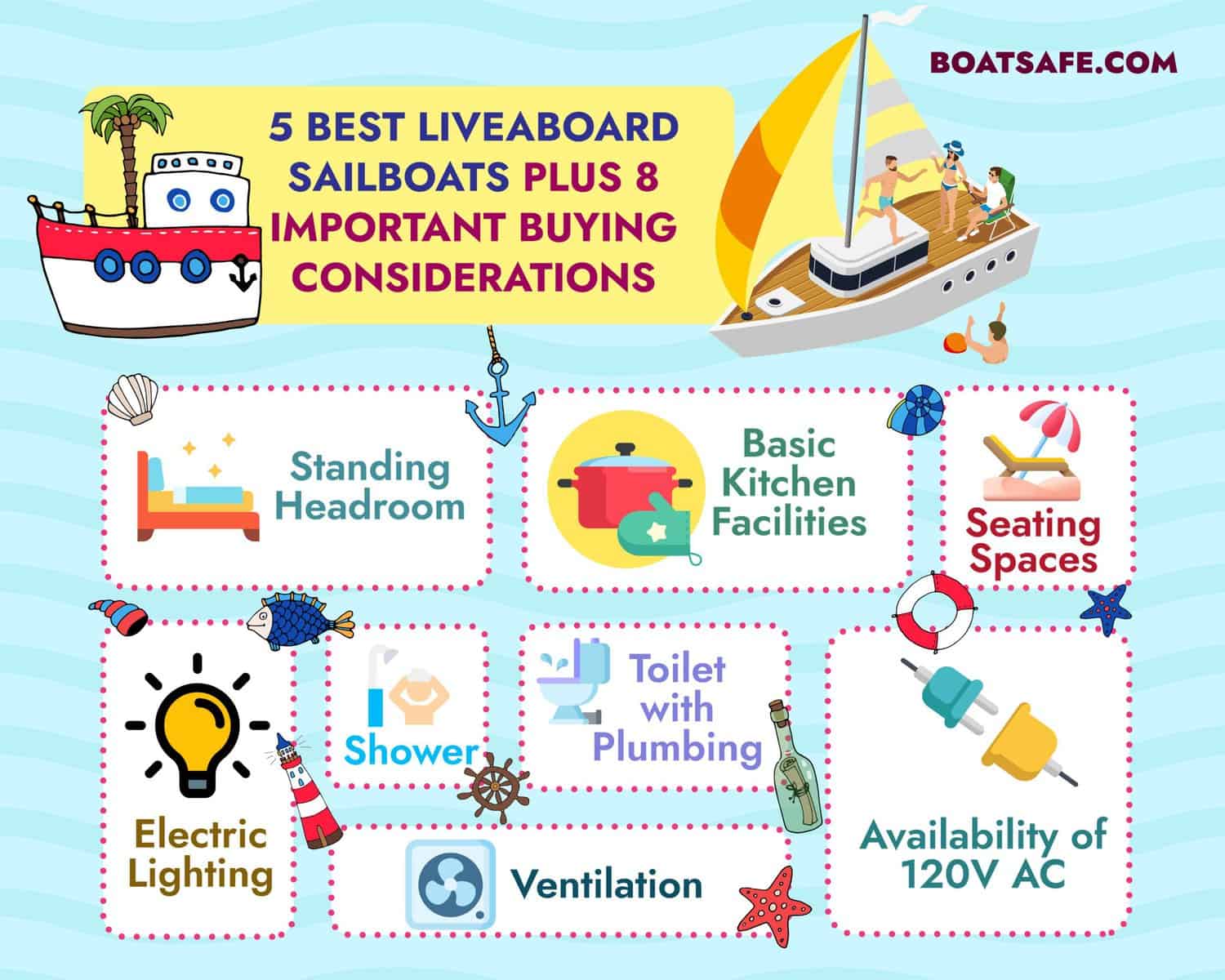
Most sailors are generally okay with any standard live about sailboats constructed after 1970 since these types typically have adequate ventilation , a usable kitchen, head, and shower. But whatever your preferences, you can be sure you will find something that will provide the level of comfort you need in most modern sailboats.
Here are 8 important factors and requirements we think are crucial when choosing the best liveaboard sailboats.
1. Standing Headroom
There’s nothing wrong with spending a couple of days in a week aboard a boat without standing headroom. However, if living aboard a sailboat is a lifestyle choice for you, consider one with standing headroom. Your body is not meant to crouch or crawl for months or years on end. With time, your back and other muscles will start to take a hit. For your overall health and wellbeing, it is best to choose a sailboat with standing headroom. Our recommendation is 5-feet 10-inch standing headroom or something within that range.
2. Basic Kitchen Facilities
A liveaboard boat without a kitchen can only mean one thing: you will be eating out every single day! While this is okay for some people, others will prefer to cook their own meals at least once in a while, regardless of their culinary skills.
We think a kitchen is a must-have for the best liveaboard sailboats, even if it doesn’t have all the modern facilities. Basic kitchen facilities should include a refrigerator or icebox, a sink, and a stove. If you find one with an oven, that’s a plus, too!
3. Toilet with Plumbing
The fastest way to spread diseases when you liveaboard a boat is to have improper human waste storage and disposal system. Sanitation facilities are among the top considerations when choosing the best liveaboard sailboats.
Using a porta-potty all year long is definitely out of the question. Besides, no one would like to live on a stinky boat or have guests come over a smelly abode. When you choose a liveaboard sailboat, look for one with a built-in and properly outfitted toilet. It should also have a safe sewage storage tank with a proper disposal system.
Many liveaboards prefer to use gym or marina facilities instead of their onboard showers. This is okay, but it doesn’t eliminate the need for bathing facilities on board. Choose a sailboat with a shower for convenience’s sake, even if you don’t use it all the time.
It is important to make sure that your bilge pump is always in good working condition, especially if you have a boat shower that drains directly into the bilge. Keep in mind that whatever goes into the drain will find its way below your floor.
5. Electric Lighting
Having kerosene lamps is okay. In fact, many sailors love to have them because it adds a certain feel and beauty to their boats. But you definitely want to consider the convenience and safety offered by electric lighting. If you plan on living aboard a boat for a long time, you will need some form of reliable electric lighting.
6. Availability of 120V AC
The best liveaboard sailboats come with 120V AC outlets for standard house electricity connections. The availability of electricity is a definite requirement for living aboard a boat. You want to have a way to charge your cell phones, computers, and use other electronic gadgets. A boat with only a 12V outlet is not good enough. It is best to choose a sailboat with 120V AC outlets if you want to enjoy electricity living aboard a boat full-time.
7. Seating Spaces
Apart from the main bed, the best liveaboard sailboats should have additional seating spaces. There should be separate spaces for sitting, working, navigating, and eating, especially if you plan on living aboard for a long time. You don’t want to be bored with the monotony of using only one space (the main bed) for all your daily activities. Having separate seating spaces has the added advantage of making your day-to-day activities more agreeable.
8. Ventilation
Perhaps the simplest requirement for liveaboard sailboats is ventilation. But it is equally essential, regardless. An opening porthole or a passive solar roof vent should suffice. The important thing to consider when it comes to proper ventilation is a boat that provides a way to let in fresh air without needing to open the main hatch.
Coastal Vs. Offshore Accommodations
And now, here’s one final factor to consider before choosing a liveaboard sailboat. How do you plan to use your boat? Do you want a sailboat that will serve primarily as a long-distance cruiser, or do you intend to use it mainly for coastal cruising?
Your intended use significantly affects the style of interior design that will be suitable for your purpose. Sailboat accommodations are greatly impacted by their cruising purposes. Coastal cruisers are likely to feature more plush layouts, complex interiors, and larger sofas. Also, these boats generally have several amenities, so it is common to have smaller storage spaces in these sailboats.
On the other hand, offshore or long-distance cruisers feature cabins that are designed and arranged to make the journey as comfortable as possible. These sailboats generally don’t have unnecessary furniture and other extras below deck to make room for increased sleeping and storage spaces.
It is easy to get carried away during the physical inspection of a sailboat, especially if the boat is equipped with modern facilities and fanciful, eye-catching amenities. But don’t get swayed by those, even though they are important for improved convenience. Your top priority should be how you intend to use the boat – for coastal cruising or offshore cruising. This should inform your choice of accommodation.
Benefits of Living on a Sailboat
Okay, why should you want to give up living on land and opt for an unstable address somewhere in the middle of the ocean? Is it even safe to do so?
Living aboard a sailboat is an exciting lifestyle that offers several benefits and challenges, too! Thousands of people across the world choose this lifestyle, and because these boats are constructed from high-quality, durable materials, you can be sure it is safe to liveaboard one.
This lifestyle offers liveaboards a cheaper alternative than living in a traditional house. This is particularly the case in waterfront cities where rental apartments and houses in the marina areas are even more expensive.
It is a lot cheaper to live in a boat if you enjoy traveling around the world on the water. And if you enjoy the marina lifestyle, you could take it a step further by owning and living in one of the several best liveaboard sailboats available.
And come to think of it, these boats require some serious investments. What’s the point of buying a “house” on the water without living in it, right? To many people, it makes more economic sense to live in their expensive boats, instead of paying extra rent for a house on the land when there is one idling away on the water.
About Chris
Outdoors, I’m in my element, especially in the water. I know the importance of being geared up for anything. I do the deep digital dive, researching gear, boats and knowhow and love keeping my readership at the helm of their passions.
Categories : Boats
Leave a Reply Cancel reply
Your email address will not be published. Required fields are marked *
Save my name, email, and website in this browser for the next time I comment.
More in Boats

What Is A Gunwale?

131 of the Best Hawaiian Boat Names

167 Patriotic Boat Names

The 138 Best Boat Names for Dog Lovers

The People’s Poncho Review and Ratings

Oru Lake Kayak Review

About Boatsafe
Established in 1998, BoatSafe is your independent guide into the world of boating, fishing, and watersports. We provide expert insights and detailed guides to help you find products tailored to your needs and budget.
Contact Boatsafe
- Address: 4021 West Walnut Street. Rogers, AR 72756
- Phone: (479)339-4795
- Email: [email protected]
Site Navigation
- How We Test
- Corrections Policy
- Privacy Policy
- Terms & Conditions
- Editorial Policy
- Affiliate Disclosure
Our Reviews

All content is © Copyright 2024. All rights reserved.
Life on a Sailboat: Everything You Need to Know About Living on a Sailboat Full-Time
Living on a sailboat full-time is often romanticized as a life of endless sunsets, gentle waves, and freedom on the open sea. Many dream of casting off the lines and setting sail for a horizon of adventure and tranquility. However, the reality of life aboard a sailboat can be as challenging as it is rewarding, as frustrating as it is relaxing, and, more often than not, as mundane as it is exciting.
This blog post aims to peel back the curtain on the picturesque scenes to reveal what daily life is really like when you call a sailboat home. We will dive into the motivations, preparations, joys, and challenges of living on a sailboat full-time, providing a realistic glimpse into a lifestyle that is far from ordinary.
Our Live-Aboard Life
Our dream of living on a sailboat was a distant one for many years. But as we watched plans and dreams fall by the wayside in the wake of COVID, we made the decision to make our dream a reality. Once the borders opened up, we made a beeline for the Mediterranean and have since spent each summer living aboard our little 29-foot sailboat Whisper. Without any experience sailing or living on a sailboat, we have taught ourselves to sail and manage life on the boat along the way.
Before we took up sail life, we had been living “van life,” and we’ve come to realize there are lots of similarities but quite a few differences between the two . However, on the whole, learning to live van life first put us in good stead to take on life on a sailboat. Unlike most people, we up-sized when we moved onto a boat.
Despite the upgrade in living quarters, the learning curve and the adjustment to living on the sea were no less challenging. Nevertheless, the shift was not as scary as we thought it might be, and the reality of living on a sailboat full-time quickly became our new normal.
Initially, our plan was to buy a boat and spend one season aboard sailing the Mediterranean before selling the boat and settling down. Instead, it’s safe to say we have fallen in love with life on a sailboat. Now, as we enter our third season, we aren’t sure when we will be ready to furl the sails for good…
Get a Taste of Life on a SailBoat
We document some of the realities of living on a sailboat full-time on our YouTube Channel in our The Vanabond Sails series.
Deciding to Live on a Sailboat
The journey to becoming a full-time live aboard often starts with the desire for change.
Some people are transitioning from one stage of life to the next as careers wind up or children move out. Some yearn for adventure and excitement, while others seek a simpler way of life. Many are drawn to the promise of freedom, the allure of the sea, and the appeal of living more closely with nature. However, the decision to live on a sailboat full-time is not one to be taken lightly. It requires thoughtful consideration and planning.
For us, it was a long-held dream to sail and live aboard a sailboat. It was also a natural progression, having spent several years living and traveling by van . We were ready for a new challenge.
It began with a conversation, then a plan, and then trawling classifieds for second-hand boat sales. Before long, the decision was set in stone, and we were on our way to Croatia to buy a boat , learn to sail it, and move aboard.
Choosing the Right Sailboat
The type of sailboat you choose is critical and depends on your budget, sailing skills, and the kind of sailing you plan to do (coastal cruising, bluewater voyaging, etc.).
Will you prefer the size and stability of a catamaran, or will you prioritize the sailing experience of a monohull? Are you looking for something small that’s easily controlled and maneuvered by a limited (and potentially inexperienced) crew, or do you require the space of a larger vessel? Are you interested in the clean lines and comforts of modern boat designs, or do you prefer the style of older boats? There are a thousand decisions to be made when choosing a boat, and your own aspirations for boat life and, of course, your budget will be critical when it comes to making this decision.
Spend as much time researching boats that are available in your price range, ask questions of sailors you know or on sailing forums, and, if possible, spend time aboard different types of sailboats to get a clearer picture of what life is really like on board before making a purchase.
Check out our full article on buying boat .
Emotional and Practical Considerations for Sail Life
Living on a sailboat means embracing minimalism and being comfortable with the idea of having less space and possessions.
You’ll need to consider the impact of such a lifestyle on relationships with family and friends, as it can mean spending long periods away from loved ones.
The decision also involves considering how to manage work or income while living at sea , which might include remote work, seasonal jobs, or living off savings.
There are plenty of options for those planning on working remotely while sailing. With the rise of remote work , there has never been more opportunity to work and sail.
All of these considerations represent potential challenges to adjusting to life at sea, but they are certainly not insurmountable. You just need to be honest with yourself and decide if your love of the open water and the freedom of living aboard a sailboat will be greater than the inconveniences.
Preparations and Adjustments
Transitioning to life on a sailboat involves a series of preparations and adjustments, both practical and psychological, to ensure a smooth and sustainable living experience.
Training and Skills
If you are thinking about taking up sailing, you should, of course, invest time in learning to sail, navigate, and understand weather patterns. While this may seem like a daunting task, it’s not an insurmountable one. Time on the water is the most important thing, so it’s time to sign up for sailing courses, start planning trips with sailing friends, join a local sailing club, or seek out opportunities to crew for other sailors.
Learning basic boat maintenance and repair is essential to manage the myriad challenges that come with life at sea.
Safety courses, such as first aid, sea survival, and radio operation, are also crucial for handling emergencies.
These skills are important for safe and comfortable sailing and are often legally required. Make sure you are aware of the licensing and registration requirements for sailors in the region you are preparing to sail.
In our case, I had experience sailing small dinghies as a child and thus some understanding of the fundamentals, while Kelli had zero experience. My existing marine license issued in Australia was recognized in Croatia, where we bought our boat. I only needed to acquire a VHF radio license to become adequately certified for inshore sailing in the Mediterranean.
We paid some local sailors to come aboard and teach us both the fundamentals of our new boat (lots of docking and anchoring practice).
Downsizing and Adapting to Limited Space and Resources
As mentioned, moving onto a boat was actually upsizing for us. With a second cabin, a flushing toilet, and a large indoor table, our relatively small 29-foot monohull seemed luxurious compared to the vans we had been living in until this point.
However, for most, moving onto a sailboat often means significant downsizing, and space becomes a premium commodity. The process of downsizing for sail life involves prioritizing essential items and learning to live without the comforts of a traditional home.
Space isn’t the only limitation on a boat. Reliance on water tanks (if you don’t have a watermaker) and solar, wind, or generator electricity often means a downshift in access to creature comforts we take for granted in a house on the grid.
Creativity in organizing and making the most of limited space and resources becomes a daily practice, requiring innovative storage solutions and multi-functional furniture. Most modern sailboats are well-designed with endless space-saving measures and designs. Nevertheless, an adjustment will likely be necessary.
Financial Planning
Financial considerations are paramount, as the cost of living on a sailboat can vary widely depending on factors like marina fees, maintenance costs, and lifestyle choices.
Setting a realistic budget that includes regular maintenance, unexpected repairs, and living expenses is essential for sustaining life at sea.
Depending on your personal aspirations for boat life, this lifestyle can be as affordable or as expensive as you want to be. For us, as a couple in our thirties still in the building and saving part of our lives and careers, we are able to live on a boat in the Mediterranean affordably and comfortably for far less than we (estimate) we would spend living a more stationary lifestyle.
Check out our full article on the Costs of Living on Sail Boat Full-Time
Overall, adjusting to the confines and challenges of sailboat living demands not only physical preparation but also mental resilience and adaptability. The transition from land to sea is a profound shift, requiring a willingness to embrace simplicity, flexibility, and a sense of adventure.
Daily Life Aboard
While there is no typical day aboard, and experiences will differ wildly from person to person and day to day, we can describe what many of our days do look like.
As we work from the boat, our weeks are generally divided into work days, Monday to Friday morning and weekends. The truth is that the novelty does wear off, and many days, especially during the working week, become just as mundane as any other lifestyle. However it never stays mundane for long, one exhilarating sail, a dolphin sighting, a picture perfect anchorage or even surviving an impromptu weather event and the thrill of living on a sailboat quickly returns.
A typical workday for us living on a sailboat often starts with the sunrise (or a little bit before if we have a lot on). Ideally, we are well rested after a still night without rolling swell or, worse, strong wind, but that isn’t always assured at sea. Mornings involve checking the weather first and foremost, all plans revolve around the direction and strength of the wind and waves.
If the weather is calm, we usually try to work in the mornings when we are fresh and focused.
We travel slowly, often spending a few days in a quiet, well-protected anchorage, on a town quay, or in a marina before moving on a short distance along the coast. On sailing days, we often sail in the afternoon when the winds are a bit stronger in the Mediterranean. On days we are staying put, the afternoon might be spent exploring a new town, getting provisions, swimming, or finding a beach to lie on and read a book. In the evening, we will cook dinner onboard and get some more work done or watch some TV.
Weekends look different, and we will take advantage of not needing to be close to reliable network services, completing longer passages along the coast, or visiting islands.
Daily Differences in Sail Life
Living spaces on a sailboat are compact and multifunctional, necessitating an organized and tidy approach to prevent clutter and ensure safety. Cooking in a small galley kitchen presents its challenges, from securing pots and pans on a constantly moving boat to managing limited ingredients and storage.
Meals often need to be simple yet nutritious, requiring creativity and planning. Our approach is to cook simple, one-pot, vegetarian meals like dal or vegetable curry two or three times during the workweek and eat leftovers for lunch and dinner. On the weekend, we like to get more creative with our meals, seeking out local produce or fresh seafood and taking our time to prepare something special.
As mentioned, resource management is a critical aspect of daily sailboat life, especially when it comes to conserving water, fuel, and electricity. Efficient use of these resources is vital, whether it involves careful water usage, monitoring power consumption, or planning the next opportunity to resupply. For us, an electricity supply is mainly dependent on the sun when we are not under motor or plugged into shore power. Extended periods of cloud can alter our plans. Similarly, if we are not careful with water, more frequent visits to refill are required, which can be limiting.
Personal hygiene and privacy take on a new meaning in the confined space of a sailboat. Showers may be quick and infrequent. In our case, we generally rinse off after a swim to bathe and take proper showers during marina stops. Personal space is limited on a sailboat and managing personal relationships can have extra challenges.
Sleeping on the boat can take some getting used to, especially when on anchor. Even on a calm day, the constant rocking of the water can be disruptive at first, and novice sailors may find they get seasick, although these symptoms usually go away after a few days. When it’s windy, or there is some swell, the noise, movement, and the ever-present worry that the boat may pull off its anchor with the movement can make it very difficult to get a good night’s sleep.
Unforecast storms, gear failure, or some other emergency can occasionally create scary and challenging scenarios, especially if disaster strikes late at night. These situations are part of the adventure but can certainly be stressful.
Despite the challenges, daily life on a sailboat is interspersed with moments of profound beauty and peace. Whether watching dolphins play in the bow wave, enjoying a sunset over the ocean, or stargazing on a clear night, these experiences often make the hardships worthwhile, offering a sense of freedom and connection to nature that is hard to find elsewhere.
The Pros and Cons of Living on a Sailboat Full-Time
Pros: the joys of sailboat living.
Living on a sailboat brings a unique set of joys and rewards that can make the challenges seem insignificant.
+ One of the most significant benefits is the sense of freedom and adventure. Sailboat dwellers have the luxury of exploring new destinations, anchoring in secluded bays, and experiencing different cultures in a way that most people never will. The ability to call a variety of picturesque locations home, even if only temporarily, is a remarkable aspect of this lifestyle. Even compared to other forms of nomadic lifestyle, waking up in your own private bay or cove is hard to re-create.
+ The connection with nature is unparalleled in sailboat living. Being surrounded by the vastness of the ocean, witnessing marine life up close, and experiencing the rhythms of the sea create a deep sense of harmony and peace. The simplicity of life on a boat can lead to a greater appreciation for the small things, like the beauty of a sunset, the changing colors of the sea, or the silence of a night watch under the stars.
+ Community and camaraderie are also central to the sailboat lifestyle. The sailing community is known for its close-knit, supportive nature, with fellow sailors often ready to lend a hand, share advice, or offer companionship. This sense of community extends across harbors and anchorages around the world, creating a global network of friends and contacts.
+ The personal growth and self-reliance developed through sailboat living are profound. Navigating the challenges and unpredictability of the sea fosters resilience, problem-solving skills, and a strong sense of self-confidence. The lifestyle encourages continuous learning, from mastering sailing and navigational skills to understanding weather patterns and marine ecosystems.
The Cons: The Challenges and Hardships of Liveaboard Life
While the joys of living on a sailboat are plentiful, the lifestyle also comes with its fair share of challenges and hardships. These difficulties test the resilience and adaptability of those who choose this way of life.
– One of the most significant challenges is dealing with bad weather. Storms, high winds, and rough seas can be terrifying and dangerous, requiring skill, experience (which you can only get by …experiencing it), and a calm demeanor to navigate safely (perhaps the trickiest thing to achieve). The stress from poor weather can be mentally draining, disrupt work, and put a strain on relationships.
– The learning curve required to become a confident and comfortable sailor is not small and can take many seasons while mastering sailing can take a lifetime.
– The constant exposure to the elements also means that maintenance is a never-ending task, with saltwater and sun causing wear and tear that must be regularly addressed to keep the boat functional and safe. Especially on an older boat like ours, fixing and maintaining gear and rigging is an endless cycle. Most systems and hardware on the boat are essential, and when they fail, there is often no one around to help. Constantly sorting out jammed anchors, engine or electrical issues can quickly become tiresome and (if you are trying to work) quite disruptive. It can also be quite stressful when critical systems fail.
– Isolation is another aspect of sailboat living that can be challenging. Long periods at sea or anchored in remote locations can lead to feelings of loneliness and disconnection from land-based communities. The confined space of a sailboat can strain relationships, making it essential for the crew, be it a couple, a family, or friends, to communicate effectively and give each other personal space.
– The financial aspect of sailboat living can also be a hardship. Unexpected repairs and maintenance can quickly drain savings, and the cost of mooring, fuel, and supplies can add up. Sailors must be adept at budgeting and often need to be resourceful in finding ways to sustain their lifestyle, which might include picking up temporary jobs or remote work.
– The physical demands of managing a sailboat should not be underestimated. It requires strength, stamina, and a willingness to tackle everything from sail repairs to engine troubleshooting. The learning curve can be steep, and the responsibility of keeping the boat and its occupants safe is a constant pressure.
Despite these challenges, many sailboat dwellers find that the hardships are part of what makes the lifestyle rewarding. Overcoming difficulties and learning to live in harmony with the sea can provide a profound sense of achievement and satisfaction.
Final Thoughts About Life on a Sailboat
Living on a sailboat full-time is a journey that encompasses the full spectrum of human experience, blending moments of sheer joy and beauty with times of challenge and adversity. It’s a lifestyle that demands resilience, adaptability, and a willingness to embrace the unknown. While the romantic allure of sailing the high seas is undeniable, the realities of daily life on a sailboat are grounded in practical challenges and the necessity of continual learning and personal growth.
The decision to live on a sailboat should not be made lightly, as it involves significant changes in lifestyle, mindset, and social dynamics. However, for those who choose to embark on this adventure, it offers unparalleled opportunities for freedom, exploration, and connection with nature. The hardships encountered along the way are not just obstacles but also catalysts for growth, leading to a deeper understanding of oneself and the world.
If you have a question about living on a sailboat full-time, let us know in the comments below or shoot us an email anytime!
Fair winds and following seas!
In 2016, I had been dumped by my girlfriend, fired from my job, and the lease on my house was running out. Facing moving back in with my parents, 26, jobless and alone I decided to listen to the message the universe was trying to send me. I took off on my first solo backpacking trip, with a one-way ticket to Bangkok and a well-thumbed Lonely Planet guide. From there I wandered Southeast and Central Asia, traveled the Great Steppe, and made my way across Russia and throughout Europe.
In Estonia I met Kelli, who, despite having a less frantic travel style, shared my my restless spirit and passion for exploration. Together, we embarked on a new journey, van life. Over four years we travelled across three different continents with three different vans.
In 2022, as the world began to re-open post COVID we took an opportunity to realise a long held dream, to live aboard a sailboat. Since then we have spent two summers in the Mediterranean, sailing and living aboard our little sail boat Whisper. When we aren't sailing we continue to live our nomadic lifestyle, guided by a philosophy of slow travel and self directed adventure be it by van or backpacking.
We find excitement through our journey into the unknown, stillness and content in the beauty of the places we discover and we find ourselves in the vastness of our world.
Hopefully, we can help you find what you're looking for too. Get lost with us and find your own path.
Leave a Reply Cancel reply
Your email address will not be published. Required fields are marked *

Sailboat Living: 10 Things To Know Before Moving On Board
Sailboat living can sound like the dream life, and in many ways it is.
Beautiful sunsets, the freedom to travel with your home, dolphins and crystal clear seas are all a huge part of the sailboat lifestyle , but anyone who tells you it’s an easy life has obviously never really lived on a sailboat!

There are times when sailboat living can feel more like a nightmare than a dream, and no matter how much you prepare there will always be a few troublesome scenarios that you just can’t predict.
However, with a little forethought and a lot of planning, there is a lot you can do to make the transition of moving from a house to a sailboat a relatively easy one.
If you’re prepared to put in the hard work now then we promise you will reap the rewards in the future. As we learnt the hard way, we’ve put together the top 10 things that everyone should know before they move onto a sailboat so that sailboat living for you can be 98% dream and only 2% nightmare!
As an Amazon Associate, we earn from qualifying purchases. We also earn from other affiliate programs. This means we may receive a small commission on products purchased through our links at no extra cost to you.
#1 A Sailboat Is Never Complete
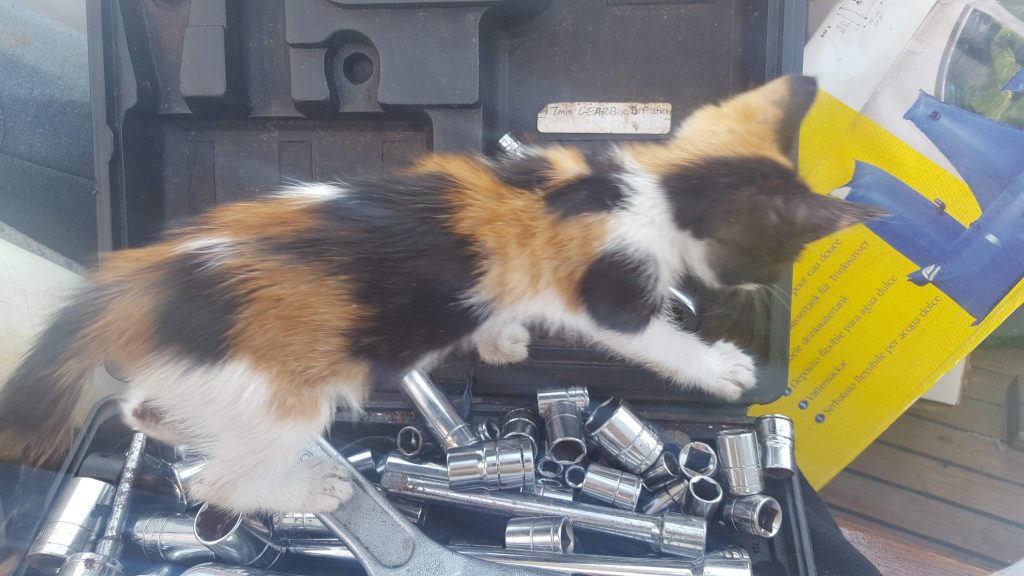
Learn this lesson fast!
Don’t expect to finish boatyard work and stop working. A sailboat breaks. Constantly. Some days it will feel as though your to-do list is endless because unfortunately, it is.
This was one of the things Adam and I were prepared for before we moved onboard our sailboat. After living on a boat in the UK we understood the crazy amount of work that has to go into maintaining something that’s constantly working.
I think a good way of looking at it would be to think of it as a house and a car combined. It has all the working parts of a house – the pipework, the electricity, the leaky windows etc.
It also has all the working parts of a car like an engine, the tires could be the sails, the lines, and all that goes along with them.
Add to that the fact that you’re putting it under huge amounts of stress at all times, in some extreme weather conditions, and you can see why things constantly fail!
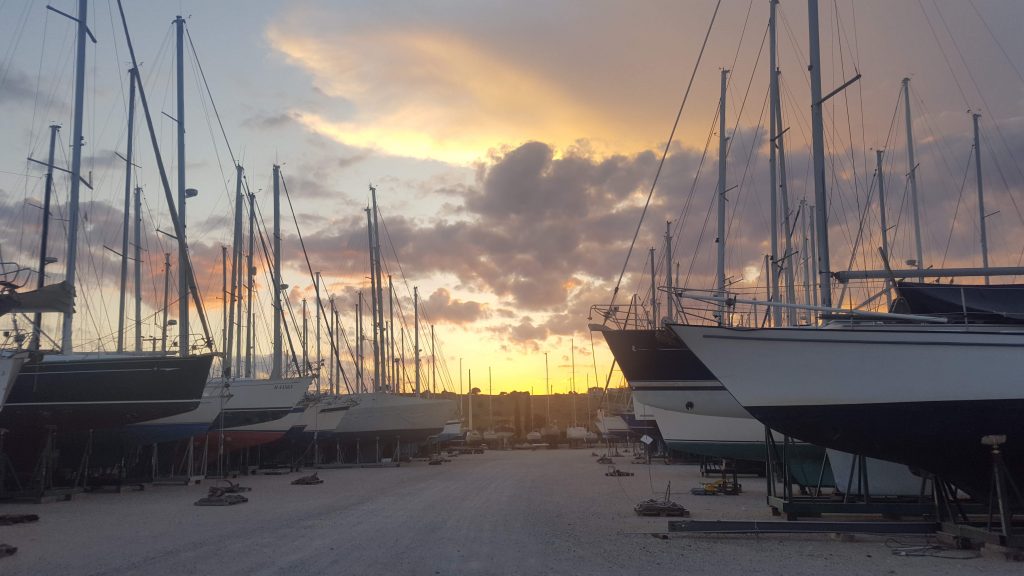
Adam and I spent the first few months of living aboard feeling as though we were just sailing from anchorage to anchorage to find chandlers so we could fix things. We made friends with some full-time cruisers who quickly put a stop to that!
They explained how if we actually wanted to enjoy time on board then we had to give ourselves time off the boat work. The broken things we could live with could wait a few days while we enjoyed a new destination.
Find out how much new sails cost
We now try to only do one or two days of boat work a week, which leaves us with a weekend ‘off’ when we’re working our jobs for three days. This suits us perfectly, but you’ll need to find a pattern that works for you to make sailboat living more enjoyable!
A bonus of living onboard is that you do have the extra time to dedicate to keeping the sailboat in tip-top condition.
Many weekend sailors find themselves with a long list of jobs at the end of the season, but (depending on how cheap/how lucky you get when you buy your boat!) if you get some jobs done every now and again through the season you’ll keep the long stints to a minimum.
#2 Sailboat Living = Tiny Space Living

Think of sailboat living as living in a glorified tent and you’ll be (partly) prepared! There is nothing glamorous about sailboat living!
You’ll be getting changed in tiny spaces where you may or may not be able to stand. You’ll be squeezing into the toilet or squeezing past people to use the kettle. It’s a juggling act, even when all your belongings are stashed away neatly.
Add to that the fact you’ll probably be ripping open cupboards every other day to find that essential item that was placed under all the other essential items and it becomes pretty hard to manage!
Our top tips for managing space onboard your sailboat are to downsize before you move in and to prioritise sailboat storage. It might be a hard thing to do to start with, but you’ll be so thankful you gave up all nonessential items before you even moved aboard.
It’s amazing how quickly you can fill a boat when you live on it! We have loads of handy tips on how to maximise limited space in our post on sailboat storage ideas – check it out before you start sailboat living!
#3 Water, Water, Everywhere But Not A Drop To Wash In

Get used to living frugally. We don’t necessarily mean your finances (though it is possible to live on a budget on a sailboat, check out what we spend monthly here).
Things like water and electricity are limited on a sailboat, especially if you’re spending the majority of your time at anchor.
Unless you have a sailboat watermaker (which we highly recommend splashing out on!) you need to get used to using as little water as possible . It’s not always easy to find when you live on the sea.
Get used to taking sea showers and washing dishes in saltwater. You can always rinse in freshwater, and washing in the sea really isn’t too hard once you’re used to it!
Set your sailboat up with a good way of making electricity as soon as you move aboard. You’ll want decent amounts of solar power and possibly a wind generator too, especially if you’re planning on spending time in countries that don’t see very much sunshine or spending winters at anchor.
You’ll also want to make sure you have a good battery bank for storing it over night, and you may even want to consider getting a small generator if you rely on power for things like charging laptops to work from.
#4 The People You Meet Will Be A True Highlight
The sailing community is what makes sailboat living. They are the most giving and generous community of people we have ever met and the best memories we have are the ones we spent with other cruisers.
It’s not always easy to meet other sailors while you’re living at anchor, so our advice is to make the effort and say hi where ever possible. People are always happy to share a drink or dinner, and a salty tale or two!
Meeting other sailors is also the very best way to learn more about sailing life. No matter how long people have cruised for they always have an experience worth sharing and learning from.
#5 The Weather Controls Your Life In Sailboat Living

We check the weather twice a day, every day. It may seem obvious that the weather is important on a sailboat, but until we moved aboard we didn’t realise quite how much it would affect our lives.
You might be desperate to move the boat and explore somewhere new but find you have no wind to sail. Or you might fall in love with an anchorage and want to stay but be forced to move because of a change in the direction of the wind.
We’ve had to leave beautiful anchorages in the middle of the night because an unpredicted storm had blown through, or been stuck in places we don’t like because the wind has meant it’s the only safe place to be.
The positives of being governed by the weather is that you’re so much more in tune with it. You get up when the sun rises, you notice subtle changes in the temperature and you learn to read the wind and clouds.

Before you move on board you should start checking the weather and anchorages around where you plan on sailing. It makes life easier if you’ve scouted out the best places to be in different weather conditions.
Check things like whether there are safe anchorages for different wind directions or whether you’ll need to use marinas (and how much they’ll be!), and check if there are any ‘bolt holes’ you can use as safe havens in the event of unexpected storms.
You’ll feel more confident and comfortable if you have all this information to hand when you start sailboat living.
#6 Sailboat Living Means Leaving Your Privacy On The Dockside
You’ll be sharing a tiny space with your crew and they will quickly learn literally everything there is to learn about you. And you them.
Before you move onto a sailboat make sure that you’re happy with sharing everything with the people you’re sailing with. I don’t mean you have to tell them about your childhood (though night passages can be pretty dull!) but be prepared to share what you eat, when you toilet, potentially what you throw up.
Expect to be walked in on while you’re changing or showering. Understand that boat toilets break – a lot – so no matter how careful you are you might well end up elbow deep in someone else’s last nights dinner!
#7 Learn To Work As A Team – Quickly
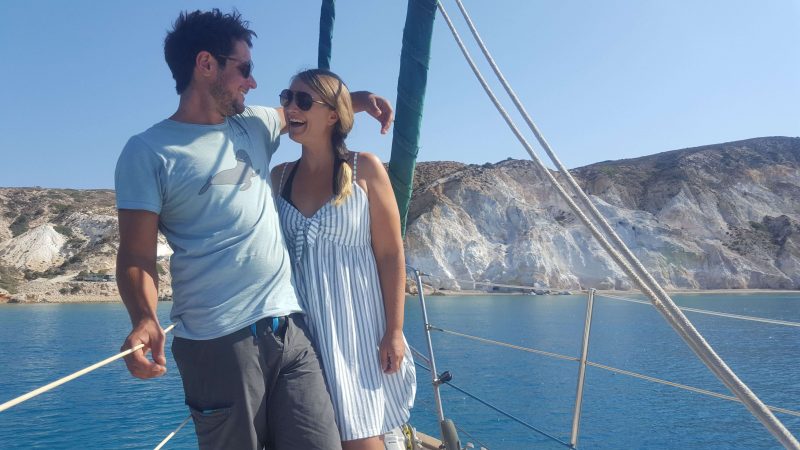
Sailboat living requires a huge amount of team work (unless you’re planning on living alone of course). You need get into a very different mindset when you live and work with the same person or people day in, day out, and when you depend on them (quite literally) to survive.
One of the biggest reasons that people quit at sailboat living is because they fall out with their partners, or call it a day before they do. Sailboat living is hard on relationships, but it can also make your relationship better and stronger if you’re prepared to work at it.
There are lots of things you can do to prepare for this change and I’ve put together a whole range of tips to help you with spending too much time with your partner .
Ultimately, one of the best things you can do is know that this isn’t going to be easy, no matter how strong your relationship is on land. Be prepared for this as a couple, and be prepared to work hard on your relationship when the tough patches come!
#8 Nature Is Incredible

I know, I know, we all know nature is incredible. But sailboat living brings you so much closer to it in so many different ways.
You see things you’d never get a chance to see on land. Every time you jump in the sea you find new sea creatures, either from snorkeling or finding them clinging on to your hull, or washed up on deck.
You see turtles, whales and rays. Birds come to find rest on your boat while you’re on long passages and dolphins swim beside you as you make waves for them to play in.

Then there’s the sunrises and sunsets, and the endless starlit skies. The thunderstorms that you’re suddenly a part of, when before you could hide inside brick walls. The constantly changing sea and sky, and the sun and wind. You become part of it, and you depend on it, and you’re terrified of it.
Sailboat living makes you feel like you’re part of the nature around you rather than just a lucky spectator. It’s certainly changed the way I see the ocean and the weather for the better and I have a new found respect and healthy fear of it’s power and awe.
#9 Prepare For Sleepless Nights

Before we set off cruising full time I had no idea how little sleep I would get. There are so many different things trying their hardest to ruin a good nights sleep on a sailboat.
Firstly, the weather. If it’s windy, you’ll be half awake all night just watching the anchor and wondering if this will be the night it pulls out and you drag into some rocks.
You’ll be waiting for the wind to shift slightly so that you’re no longer protected from the sea. And even if you’re super happy with your anchoring set up, the wind through the halyards makes a very disconcerting noise!
If the weather is calm that doesn’t mean the sea will be. You can never predict whether the anchorage you arrive in will be the rollyest place on the island, so you’ll spend a good few nights just rolling around all over the place trying your hardest to stay in your berth.

Then there’s the heat (or the cold, depending on where you sail). It can be unbearably hot inside a sailboat, so consider buying a decent hammock and sleep under the stars instead.
But if you decide to sleep outside you’re going to want a mosquito net, because those things are FIERCE. Never have I ever experienced so many sleepless nights due to a buzzing in my ears and painful bites all over my legs.
If you can find a comfortable set up with your hammock and mozzie net then sleeping outside on a sailboat is one of the most magical things ever. The stars are brighter than you could ever imagine, and there are shooting stars a plenty. The stillness of a calm night at anchor is one of the very best things about sailboat living.
If you’re sailing with a baby you can expect even less sleep – make sure you’re prepared for that!
#10 Sailboat Living Is More Difficult Than You Could Imagine (But Totally Worth It)

Difficult sounds bad, but that would be inaccurate when describing sailboat living. It’s the hardest thing I’ve ever done and the best. And part of what makes it the best is that it’s the hardest. Does that make sense?!
Sailboat living can feel like a constant battle at times. You have to trek for an hour to find the gas to light your oven to make a cup of tea in the morning. You then have to go back again because you forgot the tea bags. Things break and need fixing. You can’t sleep because of a storm. You can’t leave the boat for days because the winds up and you’re scared the anchor might pull out.
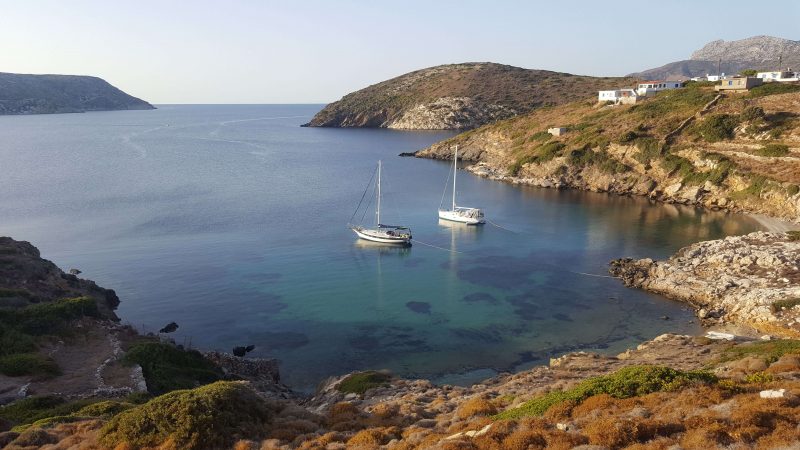
I think people run away to sea to find freedom, but like everything freedom can be defined in so many different ways.
Sailboat living takes away your freedom of easy access to food and water. It takes away your freedom to step out of your front door into relative safety. At times it even takes away your freedom to run and walk.
What it does give you is freedom from monotony. Freedom from daily routine. It gives you the freedom to travel where you want (if not when you want) and the freedom from material possessions.
It doesn’t matter what you wear on a boat, it doesn’t matter how flashy your boat is or how much you smell! At the end of the day, out on the sea, it’s just you surviving. And in a way, that’s the most free I’ve ever felt.

Similar Posts

Reefing A Sail: The Ultimate Guide

111+ Short And Unique Ocean Captions For Instagram 2024
The next chapter, a year out of work.

The 11 Best Sailing Hats 2024: Top Yachting Headware

The Beginning Of Our Adventure
15 comments.
I’ll be moving on a sailboat with my girlfriend this (still very new) year and I discovered your blog via Pinterest. We’re also writing weekly blog posts about our journey. Your writing is excellent, and I’d like to follow you on your mailing list. But it seems your form does not work. Fix it maybe? 🙂
Ah that’s strange! I can see people are still signing up, will have a look into that! Thanks for letting me know. Thanks so much for reading along. Where’s your boat? I’m so excited for you – those first few weeks aboard are the best!
I can’t seem to sign up for more. The web page has an error on my Android. Bummer.
Can you please add my email address to your email distribution list?
Thanks, Steve
So glad to come across you guys, finding out as much as we can before we take that leap. We are a couple coming to the end of a army career. The last 2 years will be in Kenya Nanyuki. Posted in June. Then we plan to get the dream sailing boat and travel. I am doing all my home work trying to find out as much as I can before we do this. Looking forward to reading about you both and tasking in everything any thing that we will I’m sure be incredible useful. Thank you Sandy
Sorry for the late reply, I’ve only just noticed your lovely comment. I hope you’re getting further along with your dream – would love to hear about it! If you need more help we’ve put together a huge guidebook detailing everything we’ve learnt, from the very beginning of the journey through to buying the boat and eventually living aboard and making it all work. https://twogetlost.com/guidebook
That’s really nice post. I appreciate your skills. Thanks for sharing.
Thanks for reading!
Thanks for the honest truth in this article. Doing all the research possible before following our dreams and in your footsteps 🙌💕⛵⚓
Thanks so much for your kind comment and really pleased we could help! Keep us updated on your journey, you won’t look back!
Wow! I am on a boat reading this while my partner is away for the first time in months, and it made me feel less insane and like there are tools to help us live our dream of minimalist sailboat life.. Thank you so much for your wise words and good tools..
I’m so pleased it helped and excited for you starting this journey! You won’t regret it, and we’d love to hear more when you find the perfect boat and move aboard! If you need more help we’ve put together a huge guidebook detailing everything we’ve learnt, from the very beginning of the journey through to buying the boat and eventually living aboard and making it all work. https://twogetlost.com/guidebook
- Pingback: How To Downsize Your Wardrobe For Boatlife | Two Get Lost
Any suggested reading on preparing your land life (home, insurance, anythin really) for departure. Sell the home or rwnt, thinks like that. Want to start preparjng a year ahead and struggling to make a plan..any blogs ir reading suggestions would be appreciated!
Hello, thanks for reaching out. First off – congratulations! You’re obviously set on your plan to move aboard and it will be amazing (and lots of other things too!!) We actually cover all this in part one of our guidebook. We go through everything we had to consider before moving aboard, things like whether to sell or not to sell, what to do with all your things, even little considerations like what to tell family and friends. We’ve included tick lists for planning the change in lifestyle. You can find it here. https://twogetlost.com/guidebook Part 2 is for after you’ve bought the boat – getting the boat ready for living aboard and all the other things that come along with living at sea. I hope it helps and please do let us know how you get on – perhaps we’ll see you out here soon!
It’s helpful to understand that when living in a sailboat, the weather controls every aspect of our lives. Not long ago, my wife and I decided to invest in a sailboat because we love the sea and nature. We’d like to buy one this year, and maybe in the future, we’ll need to read carefully your advice about living in a vessel.
Leave a Reply Cancel reply
Your email address will not be published. Required fields are marked *
13 Most Practical Boat Liveaboard Places in the US

If you’re considering moving onto your boat full-time, there is a range of practical issues you need to take into account before choosing a permanent liveaboard location in the U.S.. For starters, if you’re hoping to live aboard whilst working, you’ll obviously need to be close enough to commute to your office every day. For those of you who are retried or remote workers, you can count yourselves among the lucky ones and you have a bit more freedom to choose where you want to live.
There are plenty of stunning spots in the U.S. but not all of them are practical for year round living. At the same time, you need to be aware of hidden fees and taxes that different states impose so be sure to research any destination thoroughly before packing your bags and heading across the country. Living aboard can be a fantastic adventure, giving you the freedom to live in beautiful destinations for lower prices than waterside properties and the added bonus of being able to sail away whenever the feeling hits you. This list takes into consideration practicality and adventure because really the two go hand in hand when it comes to living on your boat!
Read on for 13 of the best places to liveaboard in the U.S. to maximise your quality of life and quality of sailing.
On this page:
San francisco bay, california, newport, rhode island, green bay, lake michigan, corpus christi, texas, san juan island, washington, tacoma, washington, lake of the ozarks, missouri, long beach, california, chesapeake bay, maryland, long island, new york, tampa bay, florida, destin, florida, oahu, hawaii.

San Francisco Bay is a paradise for sailing. The sheer variety of conditions and scenery you can find in the bay makes it an ideal destination for anyone who loves a challenge. Whilst the weather is not as warm as others on this list, if you wrap up well when you’re out and make sure your boat is fitted with a good heater, it can make an excellent choice. From the Tiburon Peninsula to Richardson Bay to the Farallones, there is a wide range of conditions and winds to contend with. At the same time, there’s plenty of developed waterfront areas to eat, grab a drink or go shopping.
One of the cheapest places to live aboard in San Francisco Bay is Oyster Point Marina where reports put the monthly cost at $350 plus a live aboard fee of $200. Generally, the harbours get less expensive as you go further inland. Good choices include San Rafael and Vallejo.
For cruising at the weekends there’s plenty of destinations on offer including Angel Island or the Petaluma or Napa Rivers. If you have longer, you could consider sailing south to Half Moon Bay or Monterey. A combination of cheap rates (if you know where to look), varied sailing, and plenty of destinations nearby make San Francisco Bay a top choice for liveaboards.
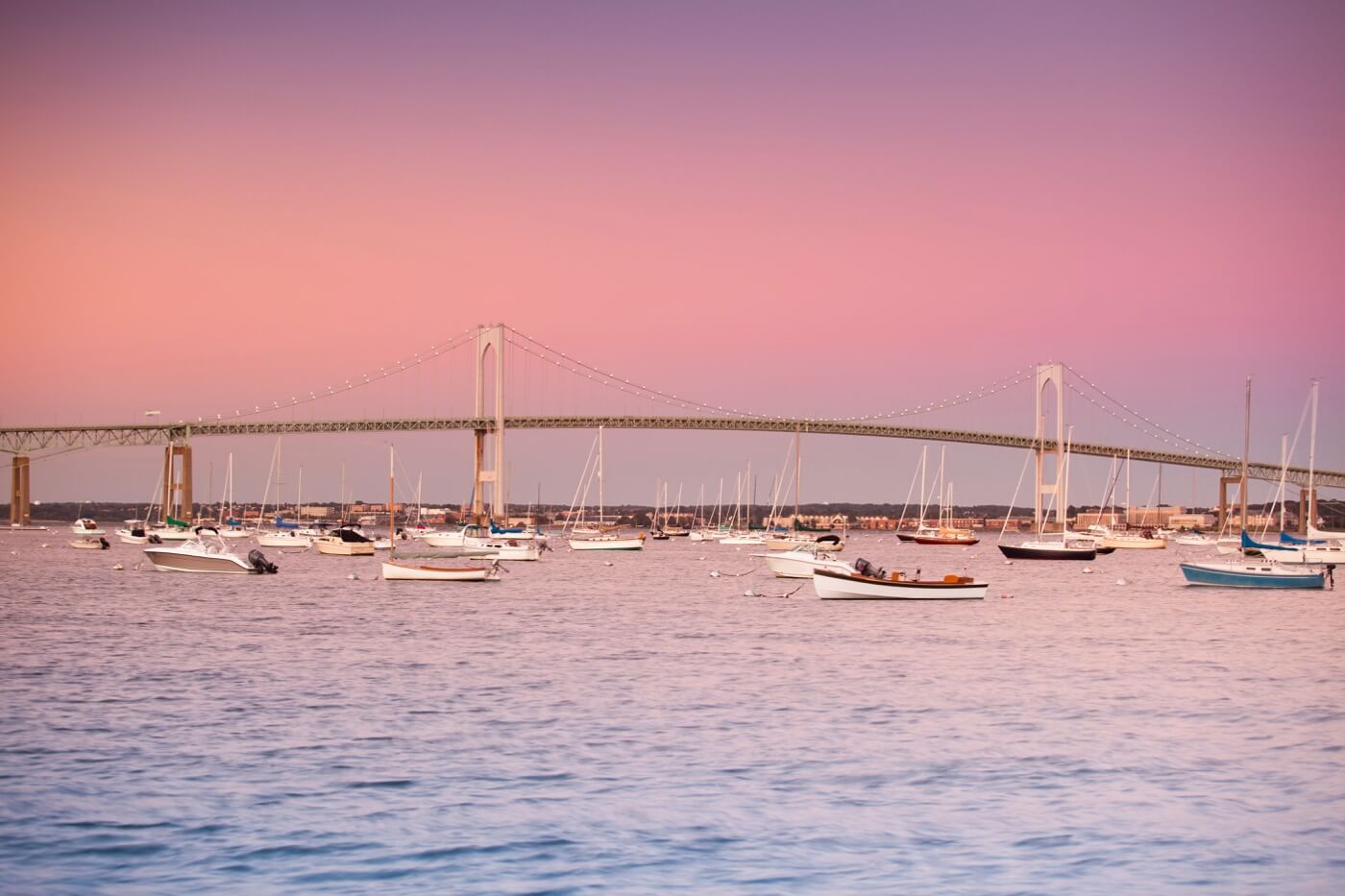
Perfectly positioned on Aquidneck Island, near the mouth of Narragansett Bay, Newport is known as the sailing capital of the world. Whilst this title is certainly up for debate and there’s plenty of other destinations claiming the same, it’s a really popular destination on the East Coast. The area is blessed with a beautiful shoreline and more than 400 miles of coast dotted with beaches. There are yacht tours and a regatta during the sailing season, which runs from mid-April to late October, and there’s some good liveaboard spots available too.
Newport’s popularity makes it an expensive choice but there are some areas that are more reasonable options. Wickford, on the west side of Newport, has rates starting at around $500 per month for a medium-sized boat with access to the town. Jamestown across the bay is also a less expensive option. Getting across to Newport itself is easy enough and the proximity means you can still enjoy all the city has to offer. If walking is more your idea of a good time, there’s a 3.5 mile cliff walk to sink your teeth (feet?) into.
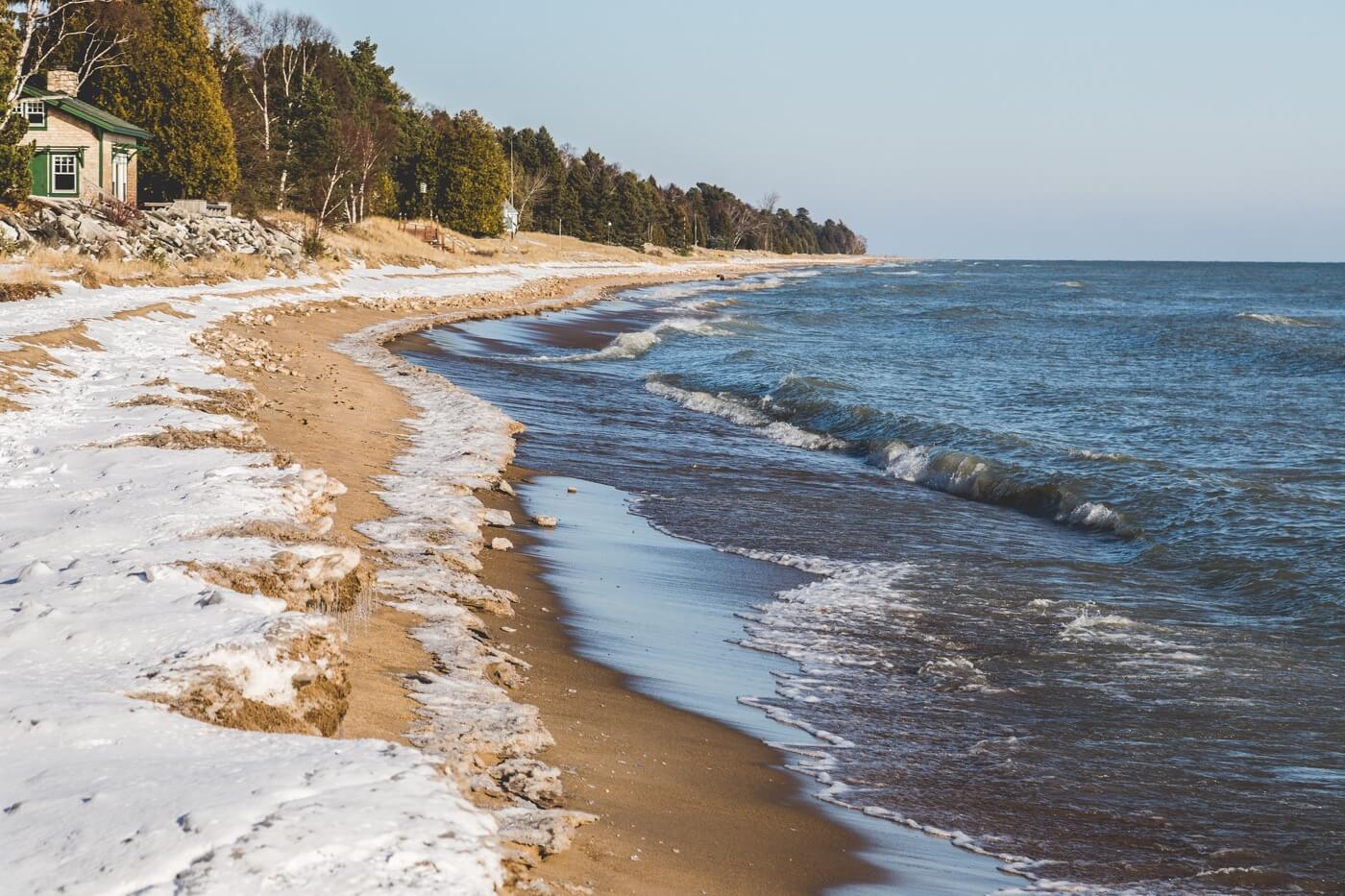
Green Bay on Lake Michigan is another picturesque and convenient choice for liveaboard hopefuls. Green Bay is separated from the rest of the lake by the Door Peninsula and the Garden Peninsula and the islands between them. The waters around Green Bay have been important for hundreds of years, serving as a key waterway for trading fur and pelts. Its history as a port can be traced back to Native American use before British, French and American traders began building military fortifications to secure their hold on the territory in the early 1800s.
You can get to Green Bay via the Fox River, Sturgeon River and Porte des Mortes. Green Bay is ideal for fishing fans as well as offering a large variety of onshore activities from shopping to eating out to the Green Bay Botanical Garden. Green Bay rates start as low as $150 a month if you’re on a strict budget. Be warned, for this price the space will be basic. For higher prices you can find somewhere nicer - you pay for what you get in this area.
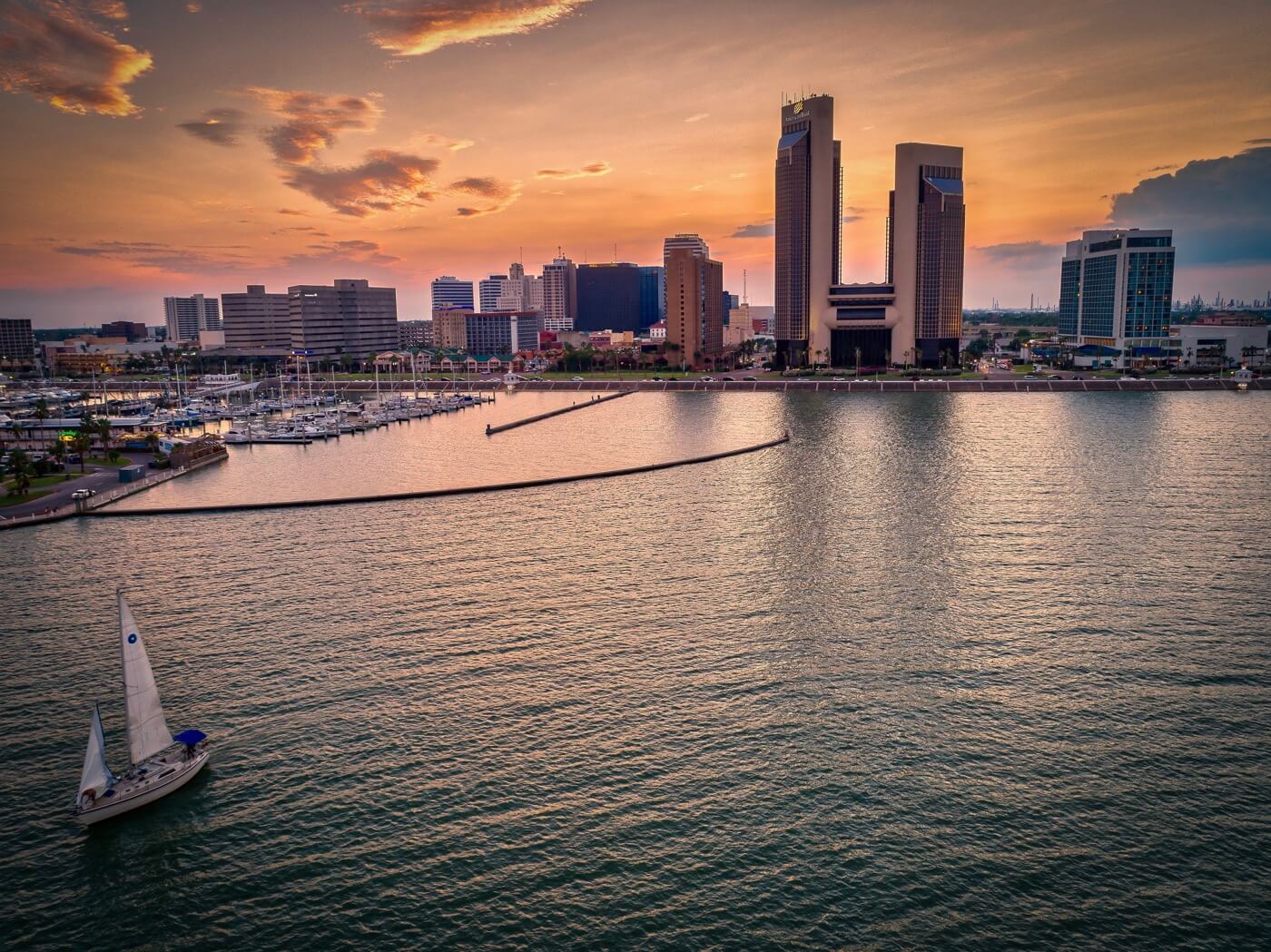
A coastal city on the Gulf Coast of Texas, Corpus Cristi is an affordable and popular option for living aboard, offering the practicality of being close to the city but the romance of life at sea. Sheltered by the Padre and Mustang Islands, the waters are home to sea turtles and migratory birds can be seen flying overhead. At the same time, the waterfront is undergoing increasing amounts of development. It’s known as a safe and laid-back city, making it a popular choice if you’re looking for an easy life.
Texas is a great state for liveaboards as boat taxes are relatively low. You can find slips starting at just $150 per month for smaller boats though prices go up for larger boats of course. One example is a 60-foot slip for $3,000 per year, working out at just $250 per month. Some marinas in Texas allow you to pay annually instead of monthly, which can also save you money long-term.
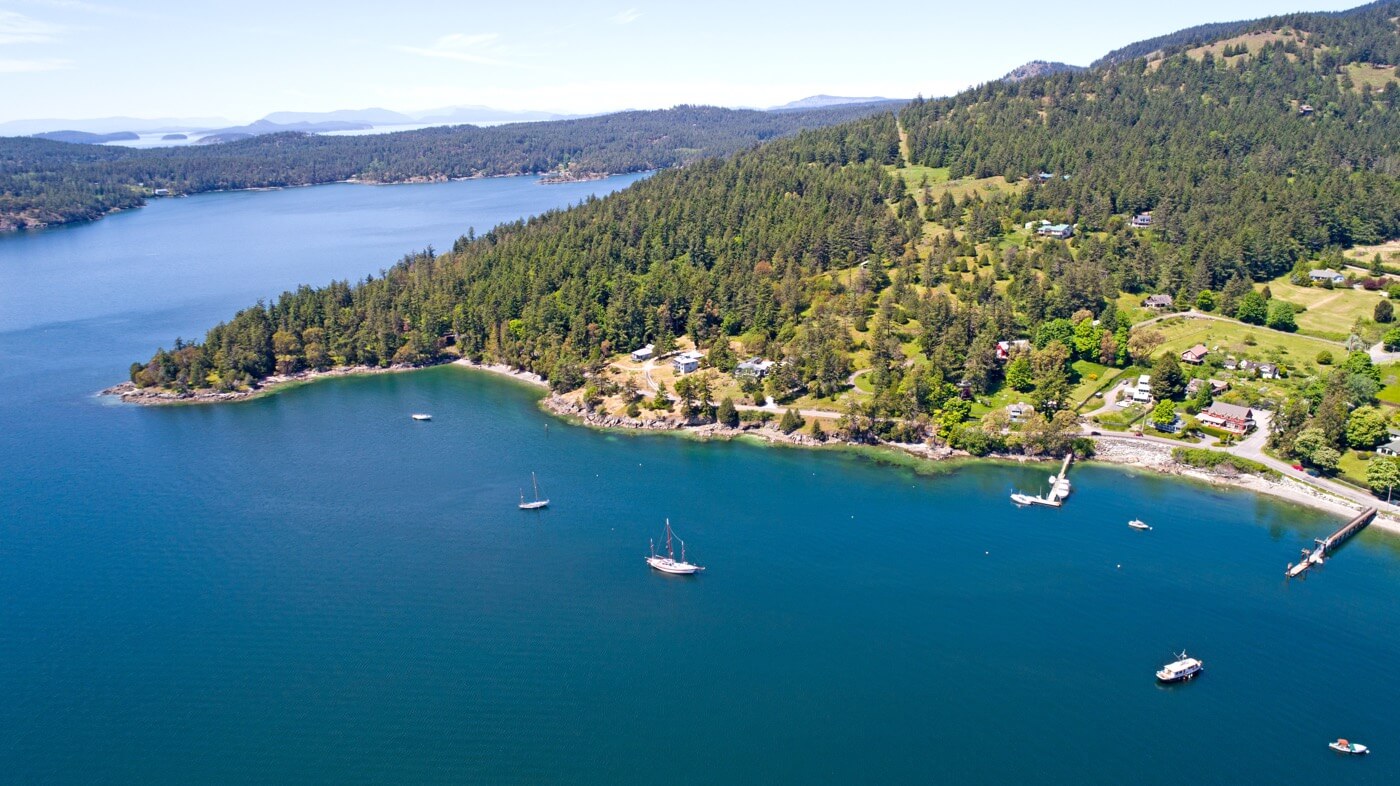
Stunning views, regular festivals and friendly locals - San Juan Island can offer a lot if you’re looking to liveaboard. San Juan is the second largest island in the archipelago between Vancouver Island in British Columbia and mainland Washington. In spite of this, at only 24 miles long, 9 miles wide and a population of 7,500, it’s definitely a small town spot. Here’s a location where everyone knows everyone.
Visitors are drawn by the woods, the beaches and the impressive views of the Olympic Mountains. For cultural activities, there’s a wide range of galleries and studios on the islands thanks to the large number of artists who call the area home. It is also the best spot in Washington for sailing. Despite the drop in temperatures, it’s suitable for sailing year-round, making it an ideal location if you’re planning to liveaboard for 12 months of the year. The best time to sail is from April to October and in the summer you can see orca wales on their annual migration. Be warned, rates tend to be higher for San Juan than other locations but if you have the budget, it’s worth it.

Tacoma is a practical choice for those looking for reasonably priced slips in Washington. Perched on the Puget Sound, Tacoma’s Commencement Bay offers liveaboards city conveniences combined with great sailing. The Puget Sound itself offers good cruising grounds and you can head north to the San Juan Islands for trips. In the South Sound, there are plenty of state parks to be found and fantastic scenery thanks to Mount Rainier only 42 miles away. This is also handy if you’re looking for adventure activities on dry land. What’s more, Tacoma neighbors Seattle and is close enough that you can head over there whenever you’re looking for a taste of the big city.
Rates for liveaboards vary depending on where you’re looking in Puget Sound. Reports for Tacoma put slips at $500 per month compared to $750 in Seattle. Nearby Bremerton is another good choice for keeping costs fairly low. The great news about this location is that there’s a lot of choices for liveaboard marinas so you can find one that suits your needs, be it an on-site gym, a kitchen, showers or storage facilities.

Coming in top for the most break-taking scenery, the Lake of the Ozarks is a truly stunning place to live. Thankfully, living aboard your boat is also fairly cheap, giving you a much better deal than if you tried to buy or rent a lake-side property. The water levels are fairly stable year round and there is a wide range of marinas to choose from who are happy to accommodate liveaboards. Different marinas offer different amenities with some set up for entertaining, with access to BBQs and bars and others better for a quieter lifestyle. It’s a good idea to tour some of them before you decide where to stay to get a feel for the different atmospheres and what you can expect.
There’s no end to the conveniences on offer in this the Ozarks with dockside cafes and restaurants aplenty, placed at convenient points along the shore. The Lake of the Ozarks is so well set up for liveaboards that you can even get food delivered to your boat! This is the ultimate spot for convenience and practicality, if takeout is your idea of being practical!
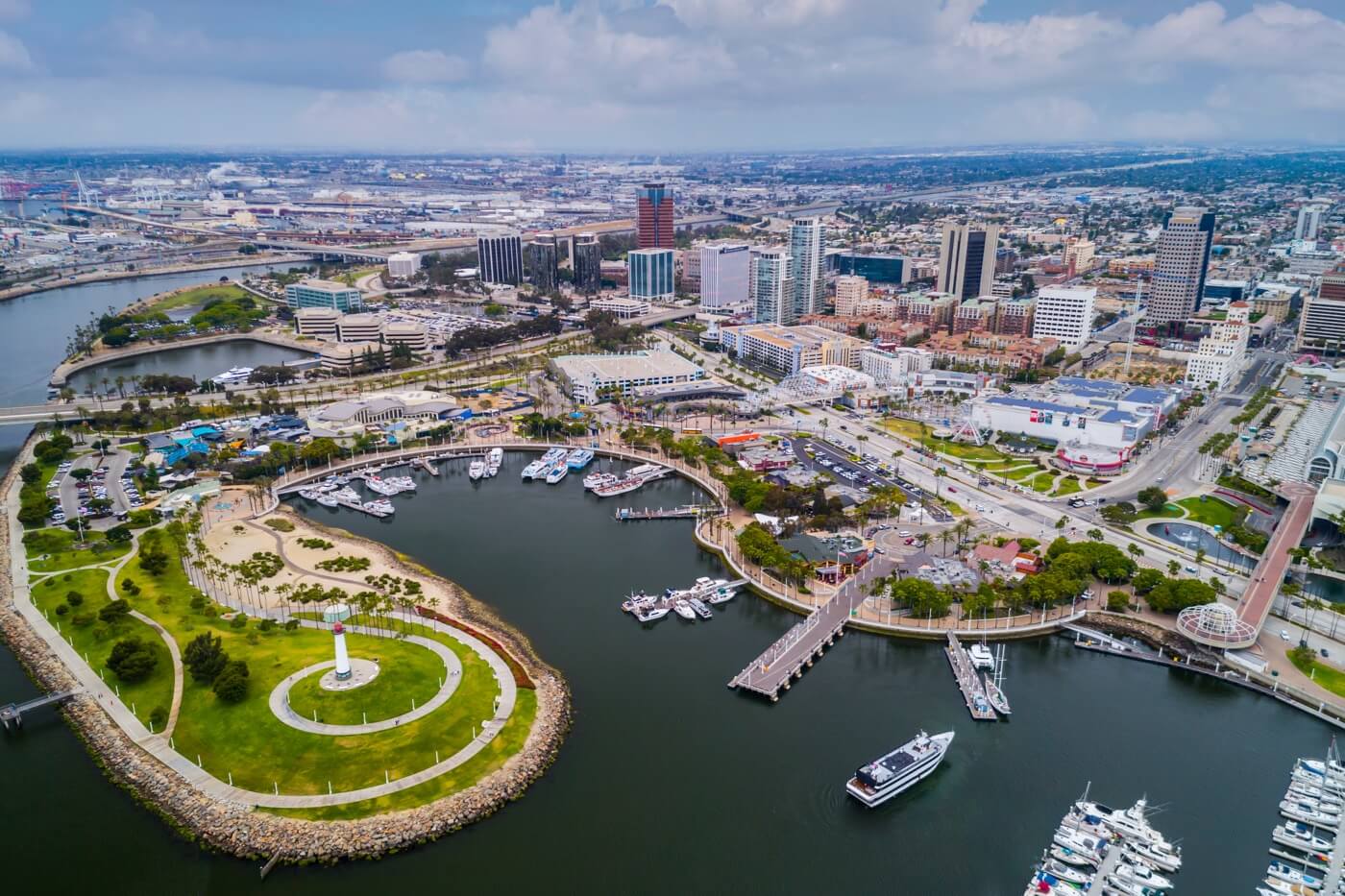
A really popular destination for liveaboards, Long Beach offers a large number of liveaboard locations that you can take advantage of. The nearby Channel Islands make a nice destination for sailing trips and you can enjoy other water-based activities like scuba diving and kayaking too. This is a fantastic choice if you want to live in a place where it’s summer all year round.
The only drawback for living aboard in Long Beach is the waitlist for slips. Thanks to a restrictive cap of 10% for liveaboards in each marina, it can be tough to find a free space. There is no fee for putting in a ‘Liveaboard Request’ but you’ll need to be patient. If you have time to spare then the rewards are worth it and it’s a good option for practicality and a high quality of life. However, this destination is not for spur of the moment decisions!
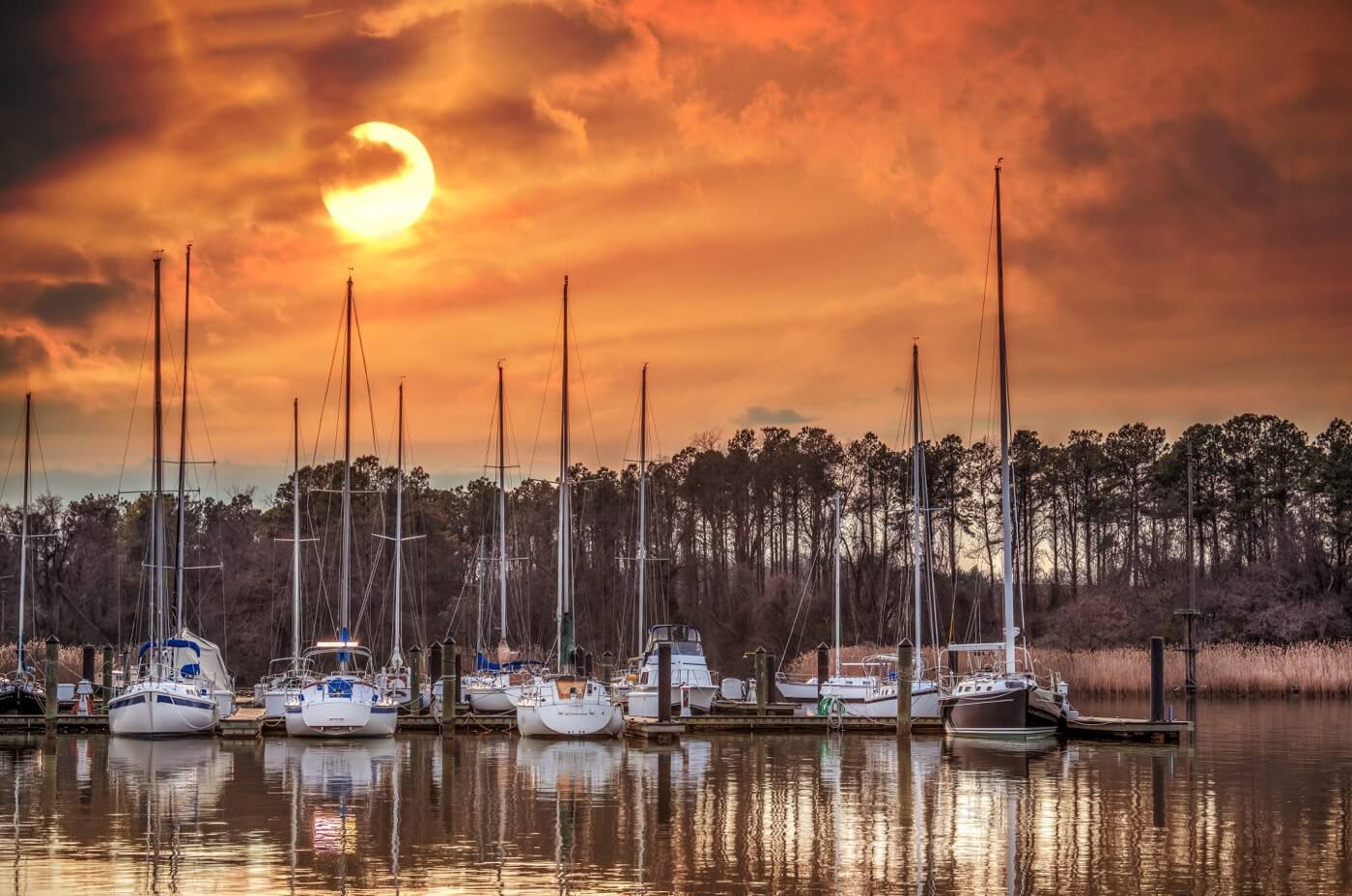
One of the most popular destinations for year-round living, Chesapeake Bay has a lot to offer liveaboards. From rich biodiversity to stunning sailing destinations nearby, there’s a whole range of reasons that this one is on the list. You can choose from a large number of different marinas around the Bay so it’s up to you if you prefer to live near Baltimore, Virginia Beach or anywhere else in the area. At the same time, the Bay offers protection against bad winter weather so it’s a practical choice for all seasons.
Prices can vary depending on where you go and how close you want to stay to urban areas. The starting point is around $300 per month and rates go up from there. For city living on board your boat, you’re going to pay between $5,000 to $8,000 a year here.

Long Island is the perfect choice for living aboard if you’re looking for plenty of destinations to sail to in your free time. You’re at the gateway to New England and can easily head to Connecticut, Rhode Island and Massachusetts in less than an hour. Of course, you can’t forget about New York City as well! Have you ever fancied sailing through Manhattan? It’s a challenging but rewarding cruise with plenty of iconic views along the way. Alternatively, head to The Hamptons for an upmarket experience in the destination of choice for wealthy city-dwellers during the summer.
Long Island itself is 100 miles long and 20 miles wide with bays and inlets, extending into the open ocean. This makes it an awesome destination for sailing, sight-seeing and living aboard. Unsurprisingly, prices are more expensive than others on this list at approximately $600 per month for a 40-foot slip.
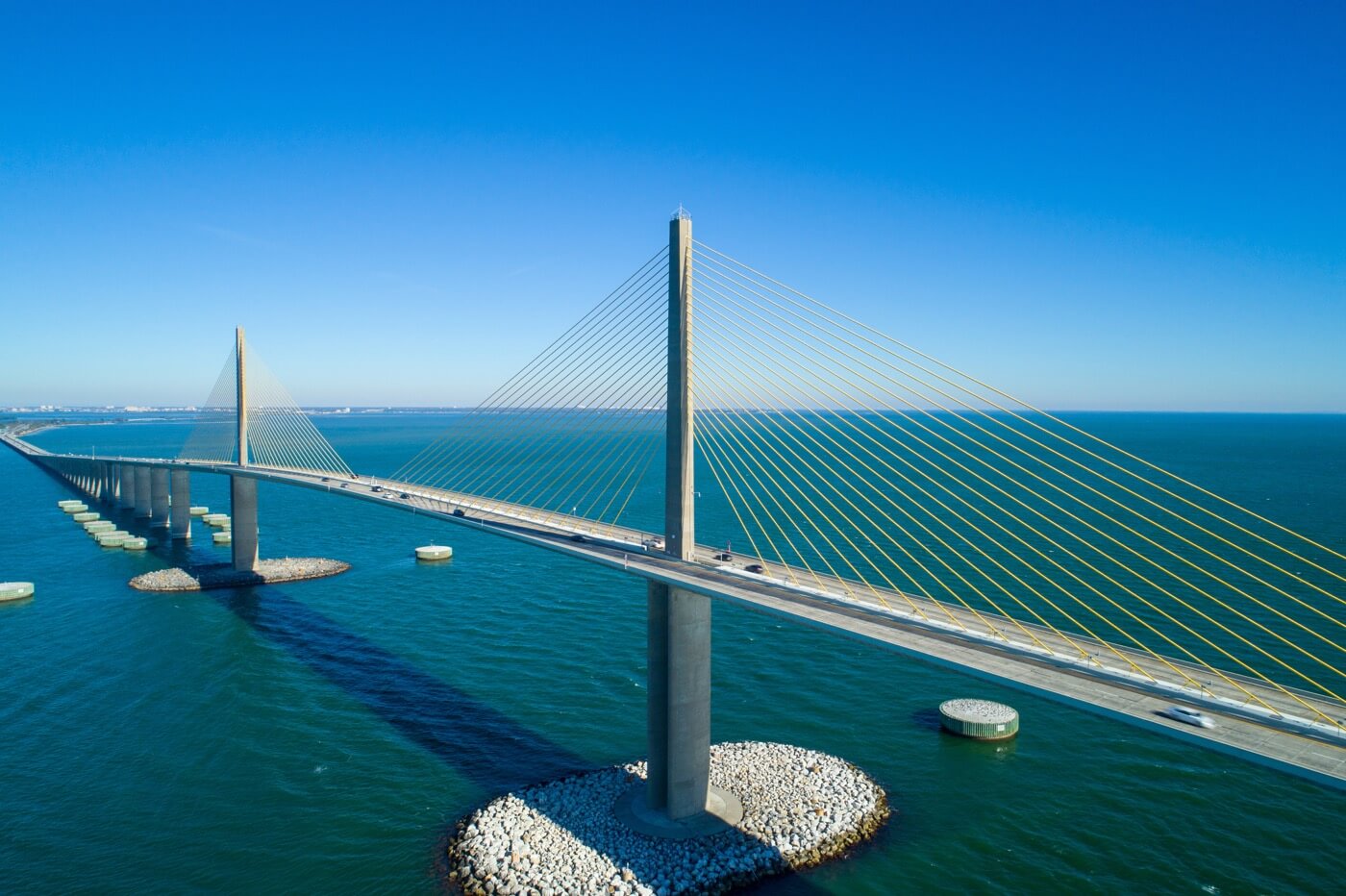
One of the biggest attractions for living aboard in Florida is the weather. You can’t beat the year long summer climate that makes really comfortable conditions for liveaboards. There’s a whole range of options if you’re looking to live aboard in Florida but Tampa Bay is an affordable choice compared to other locations closer to big cities. You’ll find a wide range of rates reflecting the location you choose.
In Tampa and neighboring St. Petersburg, you should be able to find marinas offering $500 per month for a 40-foot slip and other spots that are lower. The beauty of Tampa is that the waterfront is well developed with food, shopping and leisure options to keep you entertained. This means there’s no commute inland to get somewhere fun. Be warned, insurance can be high in Florida and local laws means there’s hoops you have to jump through in order to live on your boat. If you can take this in your stride than Florida makes a great choice.
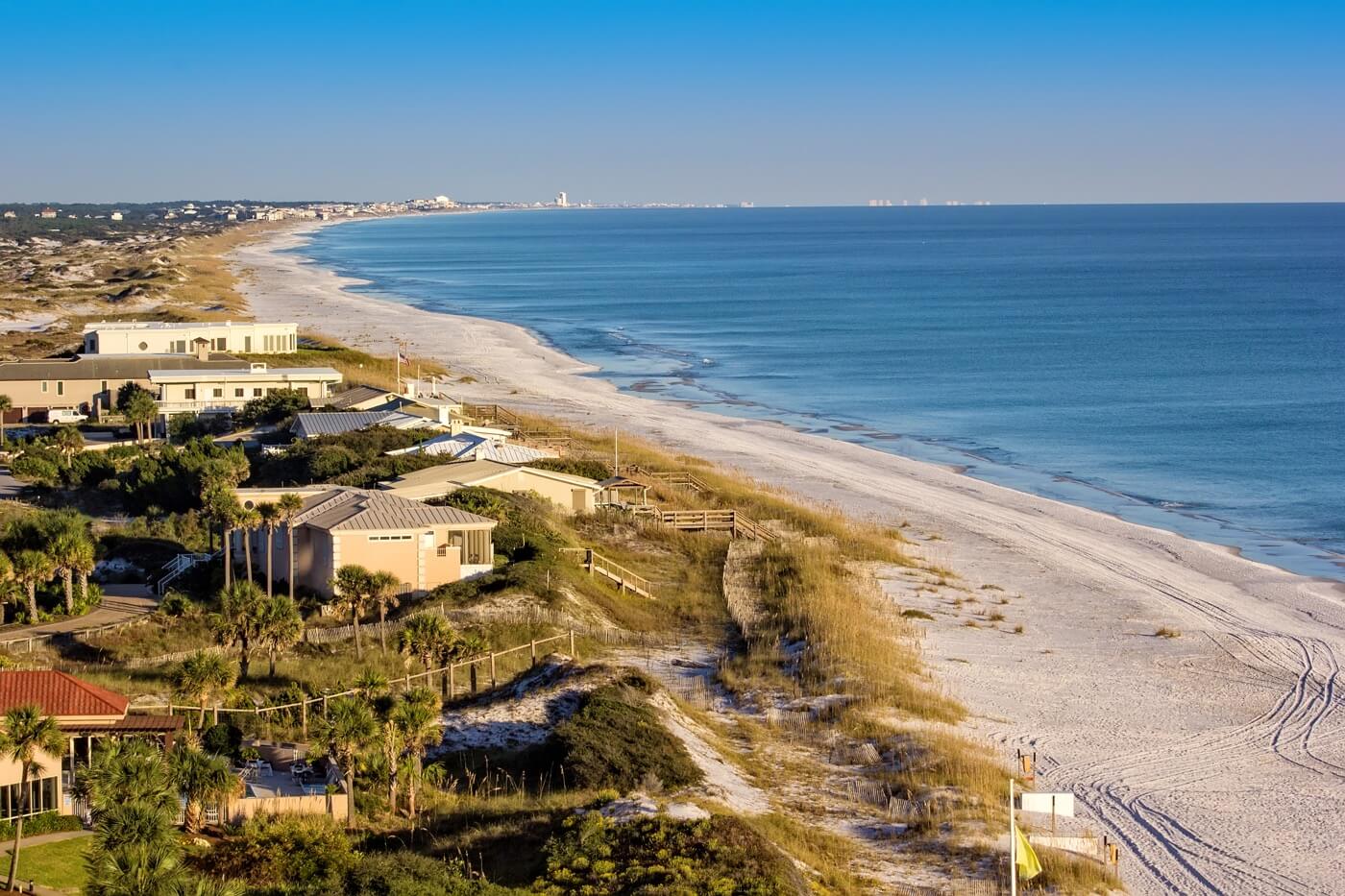
Staying with Florida, Destin is another blissful choice for would-be liveaboards who are looking for a relaxed, subtropical lifestyle. Destin’s beaches are one of the biggest draws for this location, as well as the number of barrier islands to explore. Located on the Panhandle of Florida, Destin is a paradise for leisure activities. The bay and Intracoastal Waterway is perfect for sailing beginners but getting out to the east Pass and the Gulf of Mexico is where the real fun begins. Tides, swells and cross-currents make it a challenging and exciting sailing destination.
The popularity of this destination makes Destin a more expensive choice. You will most likely have to go on a wait-list before you can find a slip. On the other hand, Florida is one of the states with the lowest taxes on boats so that can work in your favour. What’s more, Panama City is within easy reach of Destin for a weekend or head to Choctawhatchee Bay and discover the inland waterways and islands of the Santa Rosa Sound.

Hawaii is an awesome spot for sailing and the island of Maui is considered to be one of the best in the U.S. but Oahu island has a lot to offer liveaboard hopefuls. Honolulu may seem like an obvious choice but there are other options elsewhere on the island that offer practical alternatives. As with other sought-after locations, many of the liveaboard marinas on Oahu have long wait lists and it can be hard to find spaces for permanent stays. Some of the most popular options, including Haleiwa Harbour on the North Shore have wait times of up to 20 years! This is because it’s the only safe harbour on this shore.
If you can find a space, Hawaii life is worth it. From snorkelling to diving, the island life is truly tempting. In the summer months, you can sail to Waimea Bay and anchor on the sand for a romantic getaway. Thanks to the conditions, you can sail year-round and the infamous Hawaiian winds give you plenty to work with, ensuring you’ll never get bored.
Now the only question is, which destination will you choose?
lee rawlings
ahoy do you know list of low price live a boards in south florida, miami to port st lucie area

Katherine Lindell
Thinking about living aboard your boat in Hawaii? Don’t even go there. Hawaii is considered to be one of the worst sailing destinations in the country if not is the entire world. The entire boating scene in Hawaii is tightly controlled by the division of boating and ocean recreation, well known here to be corrupt and dysfunctional under the leadership of a certain Edward underwood, himself A stunning example of compromised agenda. You are currently not allowed to live anywhere in the state of Hawaii on board your vessel. And because the state’s government is so incredibly corrupt we don’t see this changing anytime soon.
Leave a comment
SAILING SCHOOL
12 knots sailing courses.
Weather forecast
Learn how to read clouds and winds like a pro

Competent Crew
Introduction to sailing. Learn how to become an active crew

Bareboat Skipper
Recreational sailing yacht skipper of vessels up to 78 feet

Issued documents

10 days live aboard course on power or sailing yacht. The key objective of the course is to teach candidates to become a recreational sailing yacht skipper and be able to charter and handle big cruising yachts on their own.
Ideal for those who already have little sailing experience and would like to learn coastal navigation.
- navigation at sea
- collision regulations
- practice at sea 200nm
- Skipper on a yacht up to 78ft. / 24m
- 20 miles offshore in day time
- in moderate weather conditions

5-day sailing course on board of a cruising yacht. The main objective of the course is to teach basic sailing terminology, parts and functions, basic sail trim, helm commands, seamanship and safety.
Ideal for candidates with little to no previous sailing experience who wish to train to become an active crew member on a power or sailing yacht.
- no special requirements
- Crew on a yacht up to 78ft. / 24m
- in sight of land and in fair weather
- only with professional skipper
Choose your sailing program. Where to start?
Introduction to sailing, on the coast.
Sailing knots - 3 hours
Understanding of the boat - 3 hours
On the water
Basic keelboat - 3 hours
Basic cruising
Safety on board - 3 hours
Live aboard sailing boat - 5 days
Live aboard power boat - 7 days
Bareboat cruising
Mandatory shore-based course for navigation and collision regulations at sea
Passage planning
Collision regulations
Practice at sea
Sailing boat - 10 days
Motor boat - 7 days
Advanced coastal cruising
Take additional shore-based courses prior to practice at sea
Long-term passage planning
Tidal navigation
Night sailing
Celestial navigation
Live-aboard course in tidal waters
Sailing yacht - 7 days
Upcoming courses

Blue water sailing practice
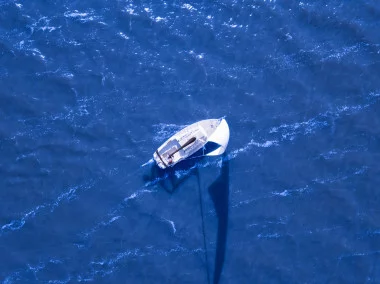
Availability
Competent crew
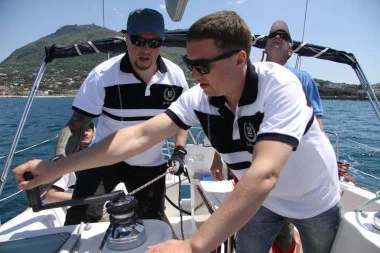
Marine weather forecasting

Watch CBS News
What it's like to live on a boat in Boston during the winter
By Mike Sullivan
Updated on: January 18, 2024 / 7:04 AM EST / CBS Boston
BOSTON - With sky high rent in Boston, some people are resorting to living on boats all year long. They are part of what is called a liveaboard community. There are a few in the city, including several in Charlestown. This way of life means braving the winters to save a buck.
"This is living the life really," laughs Larry Andersen, a liveaboard resident in Charlestown for the last eight years. "You just have to not have 30 pairs of shoes."
You will often find Andersen buried in cables with his eyes affixed to a screen. He is a video editor by trade, and he has his boat fitted with an editing suite that allows him to work on anything from ad content to music videos.

"I changed my Instagram to Larry lives on a boat. I think it's more popular just for that," jokes Andersen. "In the summer, I am on the outer dock, so I can sail until my heart's content."
His boat is docked at Constitution Marina along with roughly 50 others. Together they create a quirky community akin to an aquatic Cheers where everybody knows your name.
They even share cold nights at a nearby hotel pool. "Every Friday night they turn it up to hot tub level and everyone strolls up there with beer and wine," says Andersen.
The same hotel offers discounted rooms for rent in case of a heavy storm; however, Andersen says he has only had to do it three times since he has lived here. In the winter, the marina strings the boats together for safety. It also allows Larry a chance to stay connected electronically.

"I am plugged into shore power from a cable there plugged into the dock," explains Andersen pointing to cables running out of the windows of the boat. He also has high-speed Wi-Fi. "Everyone also assumes that I am freezing, and it really is just a couple space heaters for a room as big as someone's kitchen."
During the colder months, the boats look like floating plastic bubbles. The exteriors are shrink wrapped to create an exterior space with the exterior of the boat. The plastic wrap creates a greenhouse effect that can keep the deck of the boat in the 70s during the day.
"It's really fun creating the frame and figuring out how you want to lay it out," said Andersen.
He does the wrapping himself to save on cash. Financial freedom is a key reason for this lifestyle. Renters here pay by the foot. At 37-feet, his spot costs on average $1000 a month for the year. He pays more in the summer and less in the winter. His slip even comes with a parking space.
"A friend of mine, Isaac who lives at the marina also, has this souped-up dingy that he has, and he commutes to East Boston from his boat. He even does it in the Winter," said Andersen.
It's cheap way to live as long as you can minimize life itself.
"When I first got on here, I got a ukulele. I was like that's as big of an instrument that I can have," said Andersen, who has since upgraded to a guitar.
"I have two closets about this wide. One holds all of the shirts that I ever wear for a season. Everyone says they are sorry for me, but I think they are ridiculous," Andersen said. "I got my spot in Charlestown, my hot tub, my summer pool, Boston parking, and I walk out every morning to the smell of the ocean and skyline is on the way."
- Charlestown News

Mike Sullivan is a multimedia journalist for WBZ-TV. He returned to his home state of Massachusetts after reporting in the Midwest for more than ten years.
Featured Local Savings
More from cbs news.

How accurate are the Farmers' Almanac winter predictions?

Why Elizabeth Warren teared up during lengthy ovation at DNC

Are bees still suffering from Colony Collapse Disorder?

Kayakers find man's body in Charles River
Advertisement
Supported by
Lynch Yacht Sinking Off Sicily Proves as Baffling as It Is Tragic
As bodies were recovered, the authorities and experts wondered how a $40 million, stable and secure vessel could have sunk so quickly.
- Share full article

By Emma Bubola and Michael J. de la Merced
Emma Bubola reported from Porticello, Italy, and Michael J. de la Merced from London.
Two months after being cleared in a bruising legal battle over fraud charges, the British tech mogul Mike Lynch celebrated his freedom with a cruise. He invited his family, friends and part of his legal team on board his luxury sailing yacht, a majestic 180-foot vessel named Bayesian after the mathematical theorem around which he had built his empire.
On Sunday night, after a tour of the Gulf of Naples, including Capri, and volcanic islands in the Eolian archipelago, the boat anchored half a mile off the Sicilian coast in Porticello, Italy. It chose a stretch of water favored by the Phoenicians thousands of years ago for its protection from the mistral wind and, in more recent times, by the yachts of tech billionaires. The boat was lit “like a Christmas tree,” local residents said, standing out against the full moon.
But about 4 a.m., calamity unfolded. A violent and fast storm hit the area with some of the strongest winds locals said they had ever felt. Fabio Cefalù, a fisherman, said he saw a flare pierce the darkness shortly after 4.
Minutes later, the yacht was underwater. Only dozens of cushions from the boat’s deck and a gigantic radar from its mast floated on the surface of the sea, fishermen said.
In all, 22 people were on board, 15 of whom were rescued. Six bodies — five passengers and the ship’s cook — had been recovered by Thursday afternoon, including that of Mr. Lynch, an Italian government official said, adding that the search was continuing for his daughter.
It was a tragic and mystifying turn of events for Mr. Lynch, 59, who had spent years seeking to clear his name and was finally inaugurating a new chapter in his life. Experts wondered how a $40 million yacht, so robust and stable could have been sunk by a storm near a port within minutes.
“It drives me insane,” said Giovanni Costantino, the chief executive of the Italian Sea Group, which in 2022 bought the company, Perini, that made the Bayesian. “Following all the proper procedures, that boat is unsinkable.”
The aura of misfortune only deepened when it emerged that Stephen Chamberlain, 52, a former vice president of finance for Mr. Lynch’s former company and a co-defendant in the fraud case, was killed two days earlier, when he was hit by a car while jogging near his house in England.
Since June, the two men had been in a jubilant mood. A jury in San Francisco had acquitted both on fraud charges that could have sent them to prison for two decades. There were hugs and tears, and they and their legal teams went for a celebratory dinner party at a restaurant in the city, said Gary S. Lincenberg, a lawyer for Mr. Chamberlain.
The sea excursion was meant as a thank-you by Mr. Lynch to those who had helped him in his legal travails. Among the guests was Christopher J. Morvillo, 59, a scion of a prominent New York family of lawyers who had represented Mr. Lynch for 12 years. He and his wife, Neda, 57, were among the missing.
So, too, was Jonathan Bloomer, 70, a veteran British insurance executive who chaired Morgan Stanley International and the insurer Hiscox.
The body of the ship’s cook, Recaldo Thomas, was recovered. All the other crew members survived. Among them was Leo Eppel, 19, of South Africa, who was on his first yacht voyage working as a deck steward, said a friend, who asked not to be identified.
Since the sinking, the recovery effort and investigation have turned the tiny port town of Porticello, a quiet enclave where older men sit bare-chested on balconies, into what feels like the set of a movie.
Helicopters have flown overhead. Ambulances have sped by with the sirens blaring. The Coast Guard has patrolled the waters off shore, within sight of a cordoned-off dock that had been turned into an emergency headquarters.
On Wednesday afternoon, a church bell tolled after the first body bag was loaded into an ambulance, a crowd watching in silence.
The survivors were sheltering in a sprawling resort near Porticello, with a view of the shipwreck spot, and had so far declined to comment.
Attilio Di Diodato, director of the Italian Air Force’s Center for Aerospace Meteorology and Climatology, said that the yacht had most likely been hit by a fierce “down burst” — when air generated within a thunderstorm descends rapidly — or by a waterspout , similar to a tornado over water.
He added that his agency had put out rough-sea warnings the previous evening, alerting sailors about storms and strong winds. Locals said the winds “felt like an earthquake.”
Mr. Costantino, the boat executive, said the yacht had been specifically designed for having a tall mast — the second-tallest aluminum mast in the world. He said the Bayesian was an extremely safe and secure boat that could list even to 75 degrees without capsizing.
But he said that if some of the hatches on the side and in the stern, or some of the deck doors, had been open, the boat could have taken on water and sunk. Standard procedure in such storms, he said, is to switch on the engine, lift the anchor and turn the boat into the wind, lowering the keel for extra stability, closing doors and gathering the guests in the main hall inside the deck.

12 guests occupied the yacht’s six cabins. There were also 10 crew members.
Open hatches, doors and cabin windows could have let in water during a storm, according to the manufacturer.

Open hatches, doors and
cabin windows could
have let in water
during a storm,
according to the
manufacturer.
Source: Superyacht Times, YachtCharterFleet, MarineTraffic
By Veronica Penney
The New York Times attempted to reach the captain, James Cutfield, who had survived, for comment through social media, his brother and the management company of the yacht (which did not hire the crew), but did not make contact.
So far none of the surviving crew members have made a public statement about what happened that night.
Fabio Genco, the director of Palermo’s emergency services, who treated some of the survivors, said that the victims had recounted feeling as if the boat was being lifted, then suddenly dropped, with objects from the cabins falling on them.
The Italian Coast Guard said it had deployed a remotely operated vehicle that can prowl underwater for up to seven hours at a depth of more than 980 feet and record videos and images that they hoped would help them reconstruct the dynamics of the sinking. Such devices were used during the search and rescue operations of the Titan vessel that is believed to have imploded last summer near the wreckage of the Titanic.
After rescuers broke inside the yacht, they struggled to navigate the ropes and many pieces of furniture cluttering the vessel, said Luca Cari, a spokesman for Italy’s national firefighter corps.
Finally, as of Thursday morning, they had managed to retrieve all but one of the missing bodies, and hopes of finding the missing person alive were thin. “Can a human being be underwater for two days?” Mr. Cari asked.
What was certain was that Mr. Lynch’s death was yet another cruel twist of fate for a man who had spent years seeking to clear his name.
He earned a fortune in technology and was nicknamed Britain’s Bill Gates. But for more than a decade, he had been treated as anything but a respected tech leader.
He was accused by Hewlett-Packard, the American technological pioneer that had bought his software company, Autonomy, for $11 billion, of misleading it about his company’s worth. (Hewlett-Packard wrote down the value of the transaction by about $8.8 billion, and critics called it one of the worst deals of all time .) He had been increasingly shunned by the British establishment that he sought to break into after growing up working-class outside London.
He was extradited to San Francisco to face criminal charges, and confined to house arrest and 24-hour surveillance on his dime. In a townhouse in the Pacific Heights neighborhood — with security people he jokingly told associates were his “roommates” — he spent his mornings talking with researchers whom he funded personally on new applications for artificial intelligence. Afterward, he devoted hours to discussing legal strategy with his team.
Despite his persistent claims of innocence, even those close to Mr. Lynch had believed his odds of victory were slim. Autonomy’s chief financial officer, Sushovan Hussain, was convicted in 2018 of similar fraud charges and spent five years in prison.
During Mr. Lynch’s house arrest, his brother and mother died. His wife, Angela Bacares, frequently flew over from England, and she became a constant presence in the San Francisco courtroom during the trial.
After he was finally acquitted, Mr. Lynch had his eye on the future. “I am looking forward to returning to the U.K. and getting back to what I love most: my family and innovating in my field,” he said.
Elisabetta Povoledo contributed reporting from Pallanza, Italy.
Emma Bubola is a Times reporter based in Rome. More about Emma Bubola
Michael J. de la Merced has covered global business and finance news for The Times since 2006. More about Michael J. de la Merced
These are the people who perished when the superyacht sank off Sicily
Twenty-two people were aboard the superyacht Bayesian when a powerful storm off Sicily capsized the ship and sent it to the bottom of the sea.
Eleven were guests of host Mike Lynch , a British tech tycoon who had invited them to join a cruise to celebrate his recent acquittal on fraud and conspiracy charges. Ten were members of the ship’s crew.
Fifteen people were rescued after the storm. Seven, including Lynch, did not survive .

Dubbed “Britain’s Bill Gates,” Lynch, 59, was the son of an Irish-born firefighter and a nurse who co-founded a business software company called Autonomy. In 2011, Lynch sold the company to Hewlett-Packard for $11 billion.
But U.S. prosecutors accused Lynch and a colleague of padding the firm’s finances ahead of the sale. Lynch’s lawyers argued that HP was so eager to buy Autonomy that it failed to adequately check the books.
In June, a San Francisco grand jury sided with Lynch and acquitted him and Autonomy’s vice president for finance, Stephen Chamberlain, of all charges.
Hannah Lynch
Hannah Lynch, 18, one of Lynch’s two daughters, attended the private and prestigious Latymer Upper School in the Hammersmith section of London and had recently earned a spot at Oxford University, where she was supposed to study English.
“We are all incredibly shocked by the news that Hannah and her father are among those missing in this tragic incident and our thoughts are with their family and everyone involved as we await further updates," her school said in a statement.
Jonathan Bloomer
Bloomer, 70, chairman of Morgan Stanley International and the British insurance firm Hiscox, was a former banker who had been a director at Autonomy and testified in defense of Lynch at his trial.
Judy Bloomer
Bloomer’s wife, Judy Bloomer, 71, had been a board member of The Eve Appeal, a British charity that funds research into gynecological cancers.
Bloomer, according to the charity, was a “brilliant champion for women’s health and medical research ... an incredible supporter, committee member, and trustee of our charity for over 20 years."
Christopher Morvillo
Morvillo, 59, a well-known New York City defense attorney and a married father of two, was part of the legal team that successfully defended Lynch.
Morvillo, a partner at the Clifford Chance law firm, was a federal prosecutor in New York City from 1999 to 2005, when, among other things, he assisted in the criminal investigations in the wake of the Sept. 11 terrorist attacks, according to his work biography .
After the successful defense of Lynch, Morvillo posted a thank you to his colleagues on the firm's LinkedIn site. He also made a point of thanking his "patient and incredible wife," Neda Morvillo, and their two daughters, Sabrina and Sophia. He closed the post saying he was "so glad to be home."
"And they all lived happily ever after...." he wrote.
Neda Morvillo
Neda Morvillo, 57, Christopher Morvillo’s wife, was a jewelry designer and mother of two who ran her own business in Manhattan called N eda Nassiri .
Recaldo Thomas
Thomas, a Canadian Antiguan national, was the ship's cook. His body was found Monday.
His friend Gareth Williams told t he BBC that Thomas was a kind man who had worked as a chef for 30 years and had “the deepest, most sultry voice in the world, and a smile that lit up the room.”
Corky Siemaszko is a senior reporter for NBC News Digital.
A couple left their home to move onto a residential cruise ship — see inside their cabin on Villa Vie Odyssey
- Angela and Stephen Theriac purchased a cabin on the residential cruise ship Villa Vie Odyssey .
- The ship plans to sail around the world every 3 ½ years. Its launch has been delayed by three months.
- The cheapest dual-occupancy cabin starts at about $100,000, with an additional $3,500 monthly fee.

Angela Theriac hit a turning point in 2018.
In a span of six months, her mom and oldest brothers died, her husband faced a health scare, and she underwent two surgeries.
She said her perspective shifted: She decided to stop taking life for granted, grinding every day at work, and wondering if she'd ever have time to see the world.
"You know what?" Theriac, 53, a retired schoolteacher, recalled saying at the time to her husband. "Let's go for this big adventure and live life to the fullest."
That mission drove Theriac and her husband of almost 30 years, Stephen Theriac, 53, to purchase a cabin in March on a residential cruise ship called the Villa Vie Odyssey . They bought the cabin just one week after learning about it in a YouTube video.
"Sometimes, you just got to be adventurous and do it," Stephen, a retired deputy sheriff, told Business Insider.
Mikael Petterson, the founder and CEO of Villa Vie Residences, told BI in an email on Monday that Villa Vie Odyssey would embark "any day now." The 509-cabin residential cruise ship plans to circumnavigate the world every 3 ½ years, sailing to 147 countries and 425 destinations along the way.
Petterson declined to provide a specific sail date, saying the ship is still waiting for "the green light from DNV . It's impossible to say which day exactly." DNV is a certification and risk-assessment firm for the maritime industry.
Villa Vie Odyssey promises amenities, including three restaurants, five bars and lounges, a pool, and a golf simulator.
The ship's comprehensive itinerary is a dream for retirees like Angela and Stephen, who say cruising is a "big passion." Destinations include Australia; South America; Walvis Bay, Namibia; and Singapore.
Related stories
Before moving to Nicaragua in 2011, the couple spent most of their lives in Florida and frequently took advantage of their proximity to some of the busiest cruise ports in the US .
They estimate they've boarded 50 cruises over the past 25 years, with the longest lasting 39 days.
"I really enjoy seeing new places, learning of new cultures, trying different food, and drinking different microbrews," Stephen said. "It's a great lifestyle."
The couple told BI they paid for the smallest, least-expensive cabin on the never-ending cruise , partly funded by an inheritance from Angela's mother.
(The couple said they signed a nondisclosure agreement and could not tell BI how much they paid for their accommodation. However, the cheapest dual-occupancy interior cabins start at about $100,000 with an additional $3,500 monthly fee.)
The Theriacs said they've already been to popular cruise destinations like the Caribbean and Mediterranean. They're excited to go further — New Zealand for Stephen and tropical destinations like Bali, Indonesia, and Fiji for Angela, a self-proclaimed "water girl."
They said they have plans to rent their home in Nicaragua to a close friend.
The Odyssey cabin features twin beds and a vanity
The couple started decorating their floating condo with pillows, artwork, and "personal touches emphasizing storage," Angela said. "Our room is our bedroom, and the ship is our home."
But there's a caveat — while they can spend their days aboard the ship, they're not yet allowed to stay overnight.
The never-ending cruise was initially scheduled to set sail in May from Belfast, Ireland, following Villa Vie's acquisition of Fred Olsen Cruise Lines' more than 30-year-old Braemar vessel, now renamed Villa Vie Odyssey. However, Villa Vie has said issues like the aging ship's rudder stocks and recertification have since delayed its departure by three months.
Like many other would-be Villa Vie residents, the Theriacs flew to Belfast for the initial springtime departure date. Since then, the couple said they've been staying at hotels — including some a flight away in Liverpool, UK, where they say the nightly cost is cheaper — and spending time on other cruises.
Petterson said the Florida-based Villa Vie also provided residents with shuttles to and from the ship, food, drinks, excursions, and lodging — or a daily per diem for those who "choose to do their own thing."
But the couple has been patient and understanding of the delays — because, according to Stephen, "it's a now-or-never kind of thing."
"We're still in pretty good health and financially fine," Stephen said, reflecting on the sight of "80-year-olds getting off Princess ships in walkers." "I don't want to be that old and try to see the world. I want to do it now while I can still enjoy it."
Villa Vie would be the first ship of its kind in 22 years
Villa Vie isn't the only startup that has faced difficulties while trying to launch a never-ending voyage.
The residential-cruise industry has been plagued by issues since the inauguration of The World, the only ship of this kind, in 2002.
Startups trying to launch floating condominiums have since popped up as quickly as they've sunk — from Miray Cruises' Life at Sea Cruises , which shut down two weeks before it was supposed to embark in November, to Storylines , which has delayed its departure by seven years to 2026.
Miray's former CEO, Kendra Holmes, recently launched GlobeCruises, a concept similar to Life at Sea's three-year cruise , scheduled to sail in April.
GlobeCruises and Villa Vie are the only options vying to join The World in its extended voyage around the globe.
Are you sailing on a residential cruise ship like Villa Vie or have a tip? Contact the reporter at [email protected] or on X @brittanymchang .
Watch: Cruise ship captain breaks down 8 cruise ship disasters in movies and TV
- Main content
Ukraine war latest: Four dead as Putin pounds Ukraine - with hotel 'wiped out' and Kyiv under attack
Four people have been killed after Moscow's forces launched another round of airstrikes against Ukraine. It comes as the nation reels from one of the biggest attacks of the war by Russia yesterday. Watch a Sky News exclusive on the Ukrainian resistance operating behind Russian lines.
Tuesday 27 August 2024 11:10, UK
Please use Chrome browser for a more accessible video player
- Ukraine trying to break into new Russian region - reports
- At least four people killed as Russia pounds Ukraine, with hotel 'wiped out'
- It comes after Russia unleashed missile and drone barrage across Ukraine yesterday, killing at least seven
- Biden condemns 'outrageous' attacks
- Zelenskyy pleads with allies for help - as Kremlin issues warning
- Watch: Who are Ukraine's secret resistance?
- Your questions answered: Can Ukraine advance further inside Russia?
Russia has condemned Ukrainian moves to ban a Moscow-linked branch of the Orthodox church, describing it as an attack on Christianity and a blow to freedom of religion.
"The Kyiv regime, unfortunately, continues to show its true nature. This is an open attack on freedom of religion, an attack on the Orthodox Church as a whole, and an attack on Christianity," Kremlin spokesman Dmitry Peskov told reporters.
It comes after Ukranian lawmakers voted last week to ban the Russia-linked Ukrainian Orthodox Church (UOC).
Volodymyr Zelenskyy hailed the vote as a step to strengthen Ukraine's "spiritual independence" and signed it into law.
For context : Kyiv has accused the UOC of abetting Moscow's war by spreading propaganda and harbouring spies.
While the majority of Ukrainians are Orthodox Christians, the faith is split between the UOC and the independent Orthodox Church of Ukraine, which was recognised by the world Orthodox hierarchy in 2019.
The UOC began to distance itself from Russia after Moscow's February 2022 invasion of Ukraine, and has denied it has links with "foreign centres."
But criminal proceedings, including treason charges, have been launched against dozens of its clerics angering the Kremlin and the Russian Orthodox Church.
Russia has accused the US of helping Ukraine launch its attack on the Kursk border region on 6 August.
Around a thousand Ukrainian troops pushed into several miles of the Kursk region, which sits on Russia's western border, in an attack that largely appeared to take the Kremlin by surprise.
Russian foreign intelligence chief Sergei Naryshkin has now said that Moscow does not believe the incursion was planned alone, the TASS state news agency is reporting.
Russia has charged - without providing any evidence - the US of helping Kyiv launch the lightning attack.
What did Ukraine take?
After the invasion into Kursk, Oleksandr Syrskii, Ukraine's commander-in-chief, claimed Ukraine's forces controlled about 1,000sq km (386sq miles) in the region.
Russia's border with Ukraine is "under control" after Ukraine tried to force into the southern Belgorod region (see 9.24am post), according to Kremlin officials.
The head of Russia's western Belgorod region said the the situation on the border with Ukraine was "difficult but under control" after reports of the Ukrainian attack.
Belgorod and other border areas have been on high alert since Ukraine launched a lightning attack on neighbouring Kursk region three weeks ago and carved out a slice of territory from which Russia is still fighting to eject it.
Regional governor Vyacheslav Gladkov said: "There is information that the enemy is trying to break through the border of the Belgorod region.
"According to the Russian defence ministry, the situation on the border remains difficult, but under control. Our military is carrying out planned work. Please remain calm and trust only official sources of information."
The head of the international nuclear watchdog is visiting a nuclear power plant in Kursk today.
Rafael Grossi, chief of the International Atomic Energy Agency, says he will "independently assess what is happening" at the plant.
Last week, Russian President Vladimir Putin accused Ukraine of attempting to attack the site.
Ukraine has yet to respond to the accusations that it attacked the facility. Kyiv's forces are just 25 miles (40km) away from the plant, having crossed the border into the Kursk region and taken territory on 6 August.
The Kursk plant has four reactors with the same design as those at the Chernobyl nuclear plant, which in 1986 became the scene of the world's worst civilian nuclear disaster.
Ukrainian forces have attempted to push into Russia's southern Belgorod region, according to Russian Telegram channels.
Reports said 500 Ukrainian troops attacked two checkpoints at Nekhoteyevka and Shebekino.
The Belgorod regions border the Kursk region, where Ukrainian troops have seized territory after launching an invasion on 6 August.
In a Telegram message, Belgorod's regional governor said that "information has appeared that the enemy is trying to break through the border."
Volodymyr Zelenskyy has promised Ukraine will respond after it was hit by a second night of Russian attacks.
The Ukrainian president said rescue operations were ongoing at the sites of last night's missile attacks, which he said killed four people and injured 16 others.
In a message on his Telegram channel, Mr Zelenskyy said Ukraine will "undoubtedly respond to Russia for this and all other attacks".
"Crimes against humanity cannot go unpunished."
Rescue workers in the Ukrainian city of Kryvyi Rih are searching through ruins following another wave of Russian strikes overnight.
Two people were killed when a hotel was "wiped out" in the city, officials said, while several people are still missing.
One of the most secret weapons to combat Russia's invasion of Ukraine has started to raise its profile.
A new video posted on social media seeks to promote the covert activities of a network of Ukrainian civilians, living - and fighting - behind Russian lines.
Run by the Ukrainian special forces, this resistance movement is growing, according to its commander, who said any adult - old, young, male, female - can join.
They just need to be loyal to Ukraine - and brave.
Read the first-ever interview with the special forces commander who heads this network here ...
The foreign secretary has said he was "deeply saddened" by the death of a former British soldier in Ukraine.
Ryan Evans, 38, had been working as a safety adviser for the Reuters news agency and died after a missile strike on a hotel in Ukraine.
Mr Lammy offered his condolences to Mr Evans's family and condemned the "cowardly" tactics used by Vladimir Putin's Russia against Ukraine.
Mr Evans was part of the reporting crew staying at the Hotel Sapphire, in Kramatorsk, eastern Ukraine, which was hit by a strike on Saturday.
He had been working with Reuters since 2022.
The agency said it was "devastated" by the incident which also injured two of its journalists.
Some 60 drones have been shot down over Ukraine overnight after Russia launched 10 missiles and 81 drones in an attack.
Ukraine downed about 15 drones and several missiles alone near Kyiv during the overnight attack, local authorities have said.
Serhiy Popko, head of Kyiv's military administration, said in a statement on Telegram: "Everything that flew to the capital of Ukraine was destroyed."
Be the first to get Breaking News
Install the Sky News app for free

Bayesian yacht sinking live: 5 bodies found as tech magnate Mike Lynch and Morgan Stanley International chair both identified

Divers searching the wreck of a superyacht that sank off Sicily have identified the five recovered bodies brought up from the wreck so far, including that of UK tech tycoon Mike Lynch and Jonathan Bloomer, chair of Morgan Stanley International.
Specialist divers working with an underwater robot on Wednesday had pulled up four bodies from the wreck of the “Bayesian”, while another was pulled up on Thursday morning, according to AFP reporters.
The five identified bodies are:
- British technology tycoon Mike Lynch
- Jonathan Bloomer, Morgan Stanley Bank International chairman
- Judy Bloomer, Jonathan’s wife
- Chris Morvillo, Clifford Chance lawyer
- Neda Morvillo, the wife of Chris
Specialist divers are still searching for the last person missing, Lynch’s 18-year-old daughter, Hannah Lynch.
Read more: Mike Lynch was ‘Britain’s Bill Gates’—but the late tech millionaire would spend many of his final months under house arrest
The 56-metre (185 feet) British-flagged “Bayesian” had been anchored some 700 metres off Porticello when it was struck by a waterspout — akin to a mini-tornado — during a pre-dawn storm.
It sank within minutes.
Fifteen people were rescued, including Lynch’s wife and a woman with a one-year-old baby.
But the tech entrepreneur and his daughter, his lawyer Christopher Morvillo and his wife Neda, and Jonathan Bloomer, the chair of Morgan Stanley International, and his wife Judy, were all reported missing.
Lynch and his daughter, his lawyer Christopher Morvillo and his wife Neda, and Jonathan Bloomer, the chair of Morgan Stanley International, and his wife Judy, were all reported missing.
Many questions remain about why the yacht sank, and on Thursday the head of the company which built the boat said the tragedy could have been avoided.
“Everything that was done reveals a very long summation of errors,” said Giovanni Costantino, head of the Italian Sea Group, which includes the Perini Navi company that built “Bayesian”.
He told Italy’s Corriere della Sera newspaper that bad weather was forecast and all the passengers should have been gathered at the assembly point, all the doors and hatches closed.
Security camera footage of the ship from the shore showed the lights on its mast going out, which Costantino said indicated a short circuit, meaning that the ship had already taken on water.
“A Perini ship resisted Hurricane Katrina, a category 5 (hurricane). Does it seem to you that it can’t resist a tornado from here?” he told the newspaper.
“It is good practice when the ship is at anchor to have a guard on the bridge, and if there was one he could not have failed to see the storm coming.
“Instead it took on water with the guests still in the cabin… They ended up in a trap, those poor people ended up like mice.”
Five minutes
The passengers were guests of Lynch — an entrepreneur sometimes referred to as Britain’s Bill Gates — to celebrate his acquittal in a massive US fraud case.
The 59-year-old was acquitted on all charges in a San Francisco court in June after he was accused of an $11 billion fraud linked to the sale of his software firm Autonomy to Hewlett-Packard.
Among the survivors was Charlotte Golunski, board director of a company founded by Lynch, who has described how she briefly lost hold of her one-year-old daughter before grabbing her again. Both were plucked to safety.
Fabio Genco, a member of the Palermo Emergency Medical Services who was among the team that treated the child, described the “apocalyptic” situation he found on arriving at the scene.
“The word that the mother and all the injured kept repeating was ‘darkness’, the darkness that they experienced during the shipwreck,” he told the BBC’s Newsnight programme.
“They spoke of about five minutes, maybe from three to five minutes, from the moment the boat was lifted, raised by the waves of the sea, until it sank.”
He said the survivors rescued had been in shock: “There were truly apocalyptic scenes where everyone was searching and hoping to find the people who at that moment, were not present or just missing.”
All the survivors treated in hospital have been discharged, he confirmed.
Anarchic sea conditions
The speed with which the yacht sank, and the fact that other boats around it were unaffected, was extraordinary.
Some key questions remain, including whether the keel, which provides a counterbalance to the towering mast, was down when the storm hit.
Matthew Schanck, from the Maritime Search and Rescue Council, told AFP what happened was a “pretty unprecedented”, describing it as a “black swan event” — something that is unlikely, but has a big impact.
UK meteorologist Peter Inness described a waterspout as a “narrow column of rotating air below a thunderstorm that occurs over water”.
Like tornadoes, they suck up air in a rotating motion. Many are fairly inconsequential, but some can pack winds of more than 100 kilometres (62 miles) per hour, said Inness.
Jean-Marie Dumon, a former naval officer now with the GICAN, the French maritime industry association, added that conditions with winds of 100kph or more can “create completely anarchic sea conditions which can cause capsizing”.
Latest in Tech

The guest list for Mike Lynch’s fatal yacht party was a who’s who of players from the Autonomy scandal

U.S. investors are dominating Europe’s AI scene—and learning to live with the old continent’s regulators

Russian users get locked out of Telegram and WhatsApp as Moscow intensifies internet censorship

LVMH’s Bernard Arnault has quietly invested in 5 AI startups this year via his family office

Tesla is the EU’s top choice getting lower tariffs compared to rivals on its China-made cars
Most popular.

China fast-fashion retailer Temu soared like a rocket for two years—in just a few hours, its parent company lost more than $50 billion in market value

Sinking of a superyacht adds to questions billionaire Mike Lynch wanted to put behind him

Why this year’s Medicare Annual Notice of Change will be vital reading for beneficiaries

Australia gives workers the right to ignore their bosses outside of work hours—but employers call the rule ‘rushed’ and ‘deeply confusing’

Harris campaign raises less money at last week’s Democratic convention than Trump did at RNC

After postage price hikes and $87 billion in losses, critics of the USPS leader say latest gambit could lead to death spiral
sample of college essays

Liveaboard Sailboat Budget: A Complete Guide

Last Updated by
Daniel Wade
June 15, 2022
Living aboard a sailboat can be a cost-effective lifestyle, but only if you budget smart, predict expenses, and plan ahead.
In this article, we'll go over the basics of budgeting and what to consider when planning your finances as a liveaboard. We'll also cover the most common expenses that are unique to sailboats, along with how to save money and budget accordingly.
As a liveaboard, you'll need to budget for slip fees, fuel, maintenance, utilities, repairs, and supplies. You'll also need to factor in registration fees and mandatory safety equipment that has a limited service life.
We sourced the information for this article from marinas, maintenance records, and from our experience with sailors who live aboard their boats. Other information was sourced from financial experts experienced in budgeting.
Table of contents
Budgeting Basics
Budgeting is one of the simplest and most important aspects of money management. They don't teach it in schools, but it can be the difference between living well and falling behind. This is especially true on a sailboat because a well-budgeted liveaboard can enjoy a level of financial independence unrivaled by traditional housing.
Before we dive into the specifics of budgeting on a sailboat, we will cover some of the basic rules of managing money. This will make it easier to manage your finances in the unique liveaboard environment.
Managing Income, Savings, and Expenses
One of the most important rules of budgeting is to be aware of what's going on in your personal finances. You need to figure out how much money you're making, how much money you have, and how much money you're spending.
One way to get a handle on your finances is to audit your bank statements. Figure out how much you're taking home, when your bills are due, how much they cost, and what you have leftover. This includes things such as credit card bills, loan payments, utility expenses, rent, and other recurring expenses.
Once you have a handle on your finances, keep track of them regularly and look for ways to save. This is how you can safely determine how much you can afford to spend.
Emergency Fund
Everyone, especially liveaboards, should have an emergency fund if they can afford it. An emergency fund is a chunk of change that you don't touch unless you absolutely need to. For most people, $10,000 is the ideal emergency fund balance. It can cover everything from emergency medical bills to job loss, and it can also cover expensive sailboat repairs.
Budgeting on a Sailboat
Many people choose the liveaboard lifestyle because they believe it saves money. That's said, poor financial management can make living aboard cost more than living in an apartment or house. Proper budgeting and regular upkeep are essential to keep your liveaboard lifestyle affordable and comfortable.
Budgeting on a sailboat follows the same basic principles as any other kind of budgeting. However, the specifics are different, as a sailboat is a floating vehicle that has unique maintenance and living requirements.
Boat Payments
Many people make payments on their boats. Financing a liveaboard sailboat is common practice, and you should budget these payments the same way you'd budget a car payment or even the mortgage. Be sure to factor in boat payments when making your budget, as it should be a top priority when cash is tight.
Boat Insurance, while not mandatory in most places, can actually make your budget more secure despite the recurring expense. Sailboat insurance is generally inexpensive and rarely costs more than a few hundred dollars per year.
It provides peace of mind and protection from accidents that can easily cost thousands. Part of budgeting is preparing for unexpected costs, and boat insurance can eliminate one of the largest emergency boat expenses.
Cruising vs. Permanent Mooring
How do you plan on using your sailboat? A moored sailboat has vastly different requirements than a cruising sailboat. Cruising, whether short or far, requires several additional resources that you'll need to budget for. Remember, these requirements are in addition to regular maintenance, which will cover later in this article.
Up-to-date navigational equipment is essential if you plan to cruise on your sailboat. In the 21st century, people rely primarily on digital navigation systems when setting sail. The old tools and methods are important but less expensive to acquire, so we'll focus on Modern systems.
The most basic modern GPS chart systems cost between $250 and $1,000. These systems become obsolete somewhat quickly, so you should plan to update them once every five or ten years. More advanced navigation instruments, such as radar, last longer but cost significantly more. If you intend to use radar, plan to spend between $1,500 and $3,000 for the system and occasional maintenance.
Another consideration for cruising sailboats is rigging. In this case, we'll also include items such as sails, furling systems, winches, and other working hardware that's necessary for sailing.
Plan for regular maintenance and occasional replacement, as the consequences of rigging failure can be catastrophic. Be sure to budget for replacement canvas, tools, stays, lines, and other items that need attention before (or after) getting underway.
Dockside Liveaboard Budgeting
If you plan on spending most of your time at the dock, you don't have to worry as much about rigging and operational expenses. Instead, your expenses will likely resemble those of living in an apartment or a house.
Docking Fees
Docking fees, or slip fees, are the expenses paid to dock your boat at a marina or yacht club. Docking fees vary widely between states, cities, and establishments. Usually, docking and slip fees are calculated by an overall boat length. Additional expenses may apply to unusually wide boats, such as catamarans and trimarans.
You should budget slip fees the same way you budget a rent payment or a mortgage. Similarly, if you fail to pay your dock or slip fees, your vessel could be evicted from its mooring. Slip fees should be a top priority on your liveaboard sailboat budget.
Utilities include everything from electricity to freshwater. These connections are available only on the dock, though sailboats can generate their own electricity using their engine, solar panels, wind turbines, and other sources. Liveaboards typically connect to shore power, water, and sewage, as it requires virtually no initial expense.
Budgeting for utilities is typically fairly easy for liveaboards. This is because shore connections are often included in the price of mooring. If they're not included, you can talk to the marina and get an idea of how much you'll spend.
Fuel expenses are also a factor for liveaboards, even if they rarely move the boat. This is because fuel includes both gasoline or diesel for the engine (which should always be operational) and also propane or kerosene for heating and cooking.
Some boat stoves and heaters use mineral spirits (alcohol), so that should also be considered. There are no hookups for cooking and heating fuel at marinas, so it must be hauled in manually.
If you live aboard in an area with cold weather, such as the Pacific Northwest or the Northeast, you should allocate a considerable amount of your budget to heating fuel. Additionally, consider converting your appliances to run on the same fuel. For example, if you have a kerosene stove, consider installing a kerosene heater as well. This can simplify the budgeting process as only one fuel type has to be acquired.
Maintenance
Apart from slip fees, maintenance is likely the largest expense you'll need to budget for. It is also incomparable to home maintenance, as very few of the same tasks apply. Regular maintenance is essential and will prevent costly repairs down the line.
Safety Equipment
The U.S. Coast Guard requires several pieces of safety equipment to be aboard your boat at all times, whether moored at a marina or out at sea. Many of these items have a limited service life and must be checked and replaced regularly. These items include fire extinguishers, life jackets, flares, among others.
Engines are the source of some of the highest maintenance expenses aboard a sailboat. This is especially true for inboard motors, which must be maintained in tight spaces. It's essential to keep your engine running well. Oil changes, cooling system inspections, repairs, and filter replacements must occur regularly.
The hull of a sailboat is a magnet for undesirable sea life, such as barnacles, muscles, and other growth. Though the hull itself is quite resilient, marine growth can weigh down the boat, immobilize the propeller, damage the rudder, and cause other issues, especially while underway. The hull must be scraped and painted periodically, which can be considerably expensive. This should be included in the budget once every year or two.
Additionally, oxidation occurs on fiberglass hulls which need to be addressed periodically. This process can be done about the waterline and does not always require hauling out. Refinishing kits are available, and you can do it yourself to reduce the cost.
The deck is another source of maintenance costs that are often overlooked. The cost time required to maintain your deck depends on what kind of deck you have. A teak deck, for example, can be maintained yourself, but it's more labor-intensive than a fiberglass deck. Be sure to factor in the cost of chemicals and tools when budgeting for deck maintenance.
Wiring typically doesn't require maintenance in the traditional sense, though it will need to be serviced periodically. Marine electrical systems required fuses, bulbs, and other items that deteriorate faster in a saltwater-rich environment than they do on land. Factor in a few hundred dollars per year for miscellaneous electrical parts.
Hauling Out
Hauling out is an essential part of hull maintenance that's costly enough to include as a separate category. Your vessel will need to be hauled out once every couple of years to scrape and paint the bottom, along with performing any repairs that can't be done in the water. Hauling out is an extensive process that can cost several thousand dollars, but it isn't required very often.
Chemicals are surprisingly expensive and must be budgeted accordingly. Items such as fiberglass and resin, which are essential aboard any sailboat, can cost upwards of $100 per gallon. Several gallons could be required to complete a repair job.
Other compounds, such as paint, spar varnish, and cleaning supplies, should also be factored in. In most cases, $1,000 per year or so should cover most chemical expenses. Storing chemicals properly helps preserve them and reduce costs over time.
Most liveaboards agree that you should have a few grand tucked away for repairs each year. Things break on a sailboat, and this is especially inconvenient if the vessel doubles as your home. We've already covered chemicals for fiberglass repair, so let's go over some of the other sources of surprise repair costs.
Pipes and Plumbing
Plumbing issues are common on sailboats. Leaky showerheads, clogged toilets, and tank issues happen occasionally and must be repaired. Luckily these issues are usually not particularly expensive or complex to fix.
Sailboats must furnish their own water pressure and include systems the pump out the bilge. Potable water pumps and bilge pumps are electric and have a limited service life, which means you'll need to replace them eventually.
Cabinets, doors, gimbals, and other interior furnishings break from time to time. Budget a few hundred dollars each year for wood, stain, hinges, screws, and other miscellaneous hardware to repair interior fixtures if they break.
Leaks occur on sailboats; it's just part of life. Leaks are also the most annoying problems to fix and can be very costly and urgent. It's best to factor in some of your savings to repair leaks in the hull and the deck. Don't ignore leaks around portlights and vents, as water ingress can cause mold and quietly weaken the fiberglass structure of your vessel.
Mechanical Systems
Mechanical and electromechanical systems such as the engine, blowers, and hydraulics sometimes fail and need repair. These systems are the most costly to repair on a sailboat. They can eat up a considerable amount of your maintenance budget in a short period of time. Regular inspection and maintenance are key to preventing unwelcome mechanical issues.
Experienced sailors often already have all the tools they need to maintain and repair their boat. But if you're new to the liveaboard lifestyle, you're going to need to equip yourself with all the required implements for maintaining your vessel.
Along with basic tools, such as screwdrivers, a power drill, and wrenches, you'll also need tools to work with fiberglass, wiring, and plumbing. Most of these tools are available for discounted prices at yard sales, pawnshops, and local marketplaces.
Transportation
Transportation is an important factor to consider when living aboard a sailboat. Some sailors choose to keep a car, especially if they continue to work a traditional job in a city. This poses unique challenges in that it adds car payments, insurance payments, and fuel to the equation. Additionally, some marinas don't allow parking for free.
Ride-sharing apps such as Uber and Lyft are an alternative, but this adds up quickly. Some sailors choose to take public transportation or ride a bicycle, which can reduce the long-term load on your budget.
Sample Liveaboard Budget
Now that we've covered the basic expenses to expect when living aboard, we'll put together a sample liveaboard budget. The figures are based on someone making a monthly income of $4,000 docking a 30-foot sailboat at a reasonably priced marina.
| Monthly Expense | Type | Cost | Remaining |
|---|---|---|---|
| Slip Fees | Boat | $166 | $3,834 |
| Utilities (Electricity and Water) | Boat | $50 | $3,784 |
| Boat Insurance | Boat | $20 | $3,764 |
| Maintenance and Cleaning | Boat | $100 | $3,664 |
| Fuel | Boat | $100 | $3,564 |
| Food | Personal | $250 | $3,314 |
| Personal Supplies | Personal | $100 | $3,214 |
| Transportation | Transport | $200 | $3,014 |
| Internet and Phone | Utilities | $70 | $2,944 |
| Health Insurance | Bills | $400 | $2,544 |
| Totals: | $1,436 | $2,544 |
As you can see, a well-proportioned budget leaves plenty of wiggle room for personal expenses, saving, and stashing money away for larger unexpected expenses. These prices may not reflect your individual situation, but the point remains the same. A balanced budget can make living aboard a sailboat affordable and enjoyable.
Related Articles
I've personally had thousands of questions about sailing and sailboats over the years. As I learn and experience sailing, and the community, I share the answers that work and make sense to me, here on Life of Sailing.
by this author
Financial and Budgeting
Most Recent

What Does "Sailing By The Lee" Mean?
October 3, 2023

The Best Sailing Schools And Programs: Reviews & Ratings
September 26, 2023
Important Legal Info
Lifeofsailing.com is a participant in the Amazon Services LLC Associates Program, an affiliate advertising program designed to provide a means for sites to earn advertising fees by advertising and linking to Amazon. This site also participates in other affiliate programs and is compensated for referring traffic and business to these companies.
Similar Posts

Best Bluewater Sailboats Under $50K
December 28, 2023

How To Choose The Right Sailing Instructor
August 16, 2023

Cost To Dock A Sailboat
May 17, 2023
Popular Posts

Best Liveaboard Catamaran Sailboats

Can a Novice Sail Around the World?
Elizabeth O'Malley

4 Best Electric Outboard Motors

How Long Did It Take The Vikings To Sail To England?

10 Best Sailboat Brands (And Why)
December 20, 2023

7 Best Places To Liveaboard A Sailboat
Get the best sailing content.
Top Rated Posts
Lifeofsailing.com is a participant in the Amazon Services LLC Associates Program, an affiliate advertising program designed to provide a means for sites to earn advertising fees by advertising and linking to Amazon. This site also participates in other affiliate programs and is compensated for referring traffic and business to these companies. (866) 342-SAIL
© 2024 Life of Sailing Email: [email protected] Address: 11816 Inwood Rd #3024 Dallas, TX 75244 Disclaimer Privacy Policy
- Skip to main content
- Keyboard shortcuts for audio player
Who are Mike Lynch and the other people missing after a yacht sank in Sicily?
Bill Chappell

Mike Lynch remains missing after a luxury yacht sank off of Sicily's coast. Lynch, who sold his tech firm Autonomy to Hewlett-Packard in 2011, had recently been acquitted of fraud charges related to the sale. Dan Kitwood/Getty Images hide caption
Search teams are scouring waters along Italy’s southwestern shore, where a luxury sailing yacht sank early Monday. Six people are known to be missing, including British tech tycoon Mike Lynch and his daughter, and Morgan Stanley International Chairman Jonathan Bloomer and his wife.
Faced with the possibility that some people might have been trapped inside the ship when it sank in a storm, dive teams (including cave divers from the local fire brigade) have been looking for ways to enter the vessel.

Divers recover at least 1 body during search of yacht wreckage off Sicily
The Palermo Coast Guard told NPR on Tuesday that such an operation is complicated by the depth and position of the hull, which lies on the seabed at a depth of around 50 meters, about a half-mile from the port in Porticello, Sicily.
Lynch, a mathematician and longtime tech entrepreneur, was on a vacation voyage that apparently doubled as a celebration of his recent acquittal on federal fraud charges in the U.S. At least two members of his legal team were reportedly on the boat.
Here’s what we know about Lynch and the tragic situation off Sicily’s coast:

A rescue boat of the Italian Coast Guard operates in Porticello near Palermo, on Tuesday, a day after the British-flagged luxury yacht Bayesian sank. Specialist divers launched a fresh search for six people, including U.K. tech tycoon Mike Lynch. Alberto Pizzoli/AFP via Getty Images hide caption
Who is Mike Lynch?
Lynch, 59, made his name as the founder and longtime leader of Autonomy, a search engine and software company that helped companies manage information. Hewlett-Packard bought Autonomy for $11 billion in 2011, but Lynch then faced accusations — and then federal charges — that he had misrepresented his company’s financial health and prospects. Lynch denied the claims, saying HP was blaming him for its own problems.
Lynch was indicted on multiple fraud and conspiracy counts in late 2018, months after Autonomy’s former chief financial officer, Sushovan Hussain, was convicted of fraud (he was later sentenced to five years in prison).

Search resumes for British tech magnate and 5 others after yacht sinks off Sicily
Lynch successfully delayed extradition from the U.K. until May 2023 . Earlier this year, the case finally culminated in a lengthy trial in San Francisco that ended with Lynch’s acquittal of all charges against him in June , after he testified on his own behalf.
Also acquitted was Stephen Chamberlain, Autonomy’s former finance VP. But on Saturday — just two days before Lynch was caught in a boating catastrophe — Chamberlain was killed in a car accident , after he was struck while out for a run.
Lynch earned a Ph.D. in adaptive pattern recognition from Cambridge University. In 2006, he was awarded an Officer of the Order of the British Empire (OBE) honor for his work in the U.K.’s tech industry. After selling Autonomy, he founded an investment group focused on startups emerging from Cambridge University.
Who else was aboard?
Survivors include Lynch's wife, Angela Bacares, along with Charlotte Golunski, who works at Invoke Capital, Lynch’s venture capital firm. Golunski was on the ship with her daughter, Sofia, who had just celebrated her first birthday. In an interview with La Repubblica , Golunski said she held her little girl as she floated in darkness, using all her strength to keep her arms up and prevent Sofia from drowning. Sophia’s father was also onboard and survived.
Ayla Ronald, a lawyer who worked on Lynch’s fraud case, and her partner also escaped the wreck. Other survivors include several crew members, including two women in their early 20s who were part of the ship’s staff.
Missing along with Lynch and Bloomer are Lynch’s daughter, Hannah, 18; Bloomer’s wife, Judy; a lawyer for Lynch named Chris Morvillo; and his wife, Neda, according to local newspaper Giornale di Sicilia .
Bloomer was a partner at Arthur Andersen for some 20 years, until 1994, according to his LinkedIn profile . He then led the financial services company Prudential before taking on a number of chairman roles, including at the legal services firm DWF.
Bloomer is also currently chairman of insurance company the Hiscox Group.
“We are deeply shocked and saddened by this tragic event,” Hiscox CEO Aki Hussain said in a statement sent to NPR. “Our thoughts are with all those affected, in particular our Chair, Jonathan Bloomer, and his wife Judy, who are among the missing, and with their family as they await further news from this terrible situation.”
#Palermo , naufragio imbarcazione a Porticello: proseguono da parte dei #vigilidelfuoco le ricerche delle 6 persone segnalate come disperse. Giunti da Cagliari, Sassari e Roma i #sommozzatori speleo [ #19agosto 19:30] pic.twitter.com/7WY30ckxcK — Vigili del Fuoco (@vigilidelfuoco) August 19, 2024
What happened to the yacht?
The gathering took place aboard a massive sailing yacht called Bayesian — a term that, in mathematics and statistics, refers to probability and uncertainty. The yacht’s overall length is listed at 55.9 meters (183 feet).
The Bayesian was off the coast of Porticello when it was swamped by a violent storm before dawn on Monday morning. Numerous eyewitness accounts cited a waterspout — a highly localized spiraling storm that’s essentially a marine tornado. Around that time, the Bayesian was located in the Tyrrhenian Sea, according to the Marine Traffic tracking site.
The ship, which had 22 people aboard, sank. In the aftermath, 15 people were rescued, but one died and six were unaccounted for.
What about the rescue effort?
Helicopters and marine craft have been searching for any sign of the passengers, hoping to find more survivors. Sea and cave divers have also been part of the effort.
Italy’s fire brigade, Vigili del Fuoco, says it is working on a plan for divers to enter the sunken vessel. An initial attempt on Monday was cut short after divers were able to gain only limited access , citing furniture that blocked a passageway.
When asked about the possibility of finding any other survivors of the calamity, Comandante Vincenzo Zagarola of the Italian Coast Guard told radio station RTL 102.5 on Tuesday that given how much time has elapsed, it’s difficult to imagine a good outcome for the missing passengers. But, he said, the search will continue.
The Musings of a Hopeless Wanderer
Engaging in the eternal search for the meaning of life...or a good time.
- Netherlands
Monday, September 3, 2018
Tackling moscow by train and boat.
Our first full day in Moscow started fairly late since we were still catching up on sleep. Around 1, we finally were able to get our act together and get out the door.
We stopped by a cafe to get some breakfast and headed over to the Red Square. Since the festival is going on, we had to go through metal detectors. Once we cleared security, we reached the State Historical Museum which provided an entrance to the Red Square.

We walked the length of the Red Square, passing by the Kazan cathedral.

Under normal conditions, the Red Square is a large walking area with the State Historical Museum on one end and St. Basil's on the other end. On the sides is the Kremlin wall on one side and then the GUM shopping mall and the Kazan cathedral on the other side. Presently, the walking area has been considerably narrowed and the fesitval grounds occupying a large space between the Kremlin and the mall.
We even asked a stranger to take our picture!

After walking around the Red Square, we had to leave to meet up with our Metro Tour.
Moscow has famously pretty metro stations so metro tours are quite popular. We booked a relatively inexpensive tour through a tour group which met outside of the Red Square.
On our way, we passed by the Kremlin gardens and the tomb to the unknown soldier and the eternal flame.

We soon met up with our group which, fortunately, was only 5 people. Our guide told us that we were going to visit 8 stations during the 1.5 hour tour.
Honestly, a lot of the stations blended in to me so I won't be able to give you a detailed description of all of them. However, I did learn that there are 222 metro stations and the trains come every 2-3 minutes reliably. For that reason, Moscow > DC.
One of the first metro stations we visited had bronze statues all over of various depictions. Many of the statues had superstitions tied to them. For example, for a statue of the dog, it's held that if you rub the nose of the dog, you'll have good luck. Consequently, most of the statue is tarnished - except for the nose. I joked to Tomas that they probably rotate the "good luck" portion of the statue to ensure the entire statue gets polished.
However, I do remember some of the stations.
Novoslobodskaya is a station adorned with stained glass on the walls.

There was also Belarusskaya, which paid tribute to Belarus.

Another station which name I cannot remember but had pretty mosaics in the ceilings.

My favorite station was Komsomolskaya. It's the busiest station and a hub for other connecting trains. It was built during Statlin times and he wanted the station to embody beauty to set a good first impression to Russia.
I'd seen pictures of it beforehand since it's the most famous but it's so much more impressive in person.
Look at these ceilings!

Overall it was a very interesting tour. Not sure of any other city which could offer a metro tour. DC certainly can't...
After the tour, we headed back of the hotel to rest for a bit. We had purchased tickets to a tour hour boat down the Moscow river. The tickets were good for any time on any day and the boats left every 20min. We decided to knock the tour out that day and headed over to the pier.
We arrived at the pier and saw a boat by the company we had purchased from boarding. We approached and they shook their head and said it wasn't the right boat.
So we waited for another boat.
Another boat came along by the same company we had purchased from so weapproached them. Again - we were told it wasn't the right boat and the boat we were looking for was coming.
A third boat came along which was NOT by the company we had purchased from. By this point, it had been longer than 20min waiting and I was starting to suspect that the correct boat was actually one of the ones which turned us away. We approached the 3rd boat to ask if they knew which boat we should be on. However, when we approached, they waved us aboard without scanning our tickets.
So, we boarded the 3rd boat....which was definitely not ours.
We settled into an upper deck, open air table to take in the views.
We passed by pretty buildings.

The somewhat impressive cathedral of Christ the Savior.

This random statue.

After about hour on the cruise, Tomas remarked that it had been about an hour so we should be turning around soon. I reminded him that we actually had no idea how long this cruise was or where we would be dropped off. Since we were on the wrong boat.
Fortunately, it did turn around and took us back to the pier.
For dinner, we decided to go to this burger place, Black Star Burger, which our guide told us about. Tomas really liked his - I thought mine was OK. It was a decent size patty with a mountain of Cole slaw on top. We've realized that apparently Russians dislike getting their hands dirty while eating so some restaurants will give out gloves to use. This particular restaurant gave out black gloves.
Tomas modeling our dinner.

Since little mum has been asking about pictures which show my feet, I assume she wanted to see my new shoes. I recently bought Allbirds which are suppose to be super comfortable walking shoes which you wear without socks and can be washed. I didn't wear them too extensively beforehand, so that was probably my first error. I also didn't bring another pair of good walking shoes, which was likely my second error. The Allbirds were great the first two days without socks. Midway through the third day, my right foot was quite unhappy. Left foot was a trooper. So, now I have a bandaid on the heel of my right foot and wear socks.
No comments:
Post a comment.

IMAGES
COMMENTS
What is the best kind of live aboard boat? Like buying a house or renting an apartment, personal taste weighs heavy when choosing a boat. People sail around the world and live on vessels as small as 24 feet (7.3 M) and as large as hundreds of feet. Essentially, as long as the vessel is seaworthy, it is possible. Of course, the longer and wider the vessel the better it will fair on ocean ...
Living aboard a sailboat is an exciting lifestyle choice, but there are lots of considerations you'll need to make. First and foremost, you have to pick a boat to live in.
So to help you navigate those deep waters (no pun intended), here is an article summarizing the 13 best liveaboard sailboats under 30 and 50 feet. So what are the 13 best liveaboard sailboats? Catalina 30. Nor'Sea 27.
Many dream of living aboard a sailboat, but finding the right one can be daunting. There are many different types, and countless manufacturers have come and gone over the years. Here's a list of 17 options - a sailboat for every sailor on every kind of budget. #sailboat #sailor #liveaboard
Liveaboard sailboats that are cheap but actually good include Westsail 32, Alberg 30, Tayana 37, Catalina 30, Ericson 35, Albin Vega 27, Bristol 32, Morgan 323, Contessa 32, Pearson 365, Hunter 31, Cal 34, and Tartan 30. The prices of these boats range from $5,000 to $50,000 or more. Living aboard a sailboat on a budget doesn't mean you have to ...
Living aboard requires careful attention to maintenance, good organization, and an actual desire to live the lifestyle. You can successfully live on a sailboat without experience if you're willing to make some changes to your lifestyle, reduce the amount of stuff you own, and stay on top of maintenance.
Who hasn't dreamed of living aboard a yacht? The notion has certainly gone through every boater's mind at one time or another, and with more people working remotely that ever before, living the nomad lifestyle is on the rise. All of the liveaboard yachts we have chosen have exceptional sea-keeping abilities, an extended nautical mile range to tackle long passage, fully-equipped interior ...
Liveaboard sailboats in clean and operational condition cost anywhere between $10,000 and $30,000, but some excellent vessels cost less.
Living on a Boat: Beginner's Guide for Liveaboards It's easy to romanticize the idea of living on a boat full-time; however, it's an alternative lifestyle like that takes preparation, organization and an ability to roll with changes. When you commit to moving aboard, make checklists of necessities and talk to your partner about deal-breakers.
This is a guide for how to live on a sailboat - but be warned, if you have any desire for the liveaboard lifestyle, you might quickly become on of us! Living aboard a sailboat requires an enjoyment of water, being okay with small living, and a sense of adventure.
Considering living in a sailboat? In this insider's guide to living the sailboat life, we share how to buy a boat, pros & cons, costs & more.
Photo via Advantage Yacht Sales. Still a sailboat but with a lot of great living space, the French Fountaine Pajot Isla 40 is an ideal liveaboard platform. Catamarans are ultra-comfortable and can be spec'd with up to four cabins so living aboard with a family is a possibility.
What does living on a boat full time look like? Here's a glimpse into the world of the liveaboard.
Taking the plunge to live on a sailboat is usually a huge decision, especially as living aboard a boat is an exciting lifestyle choice. However, there are lots of things to consider before buying a boat that will suit your needs and also be nearly as comfortable as a traditional…
Living on a sailboat full-time is often romanticized as a life of endless sunsets, gentle waves, and freedom on the open sea. Many dream of casting off the lines and setting sail for a horizon of adventure and tranquility. However, the reality of life aboard a sailboat can be as challenging as it is rewarding, as frustrating as it is relaxing ...
Sailboat living - The top ten things you should know before moving onto a sailboat, including some handy hints about how to best prepare!
Living aboard can be a fantastic adventure, giving you the freedom to live in beautiful destinations for lower prices than waterside properties and the added bonus of being able to sail away whenever the feeling hits you.
12 Knots Sailing School offers 5 to 10 days sailing courses in most exotic destinations. Learn to sail and make a fantastic adventure of a lifetime. Check out our live aboard sailing classes, and sign up for lessons choosing date you like
BOSTON - With sky high rent in Boston, some people are resorting to living on boats all year long. They are part of what is called a liveaboard community. There are a few in the city, including ...
Only dozens of cushions from the boat's deck and a gigantic radar from its mast floated on the surface of the sea, fishermen said. In all, 22 people were on board, 15 of whom were rescued.
The configuration you choose depends on how many people attended live aboard and what layout you prefer. Catamarans offer superior stability and motion comfort, which is a big advantage when living aboard. Overall, conditions under sail and in the harbor are likely much better aboard a properly-proportioned catamaran.
There were 22 people aboard the superyacht Bayesian, including tech tycoon Mike Lynch, when a powerful storm off the coast of Sicily capsized the ship and sent it to the bottom of the sea.
Angela and Stephen Theriac purchased a cabin on the residential cruise ship Villa Vie Odyssey. The ship plans to sail around the world every 3 ½ years. Its launch has been delayed by three months ...
That brings an end to our live coverage of the war in Ukraine for this evening - thanks for following along. ... the Russian-born businessman had been travelling aboard his private jet and was the ...
Bayesian yacht sinking live: 5 bodies found as tech magnate Mike Lynch and Morgan Stanley International chair both identified BY Sonia Logre and AFP The first body has been recovered from the ...
catamaran; gulet; motorboat; powerboat; riverboat; sailboat; yacht; powerboat. sailboat living. Share on Facebook Share on Twitter. 191. IMAGES. Meet Victoria Fine ...
Living aboard a sailboat can be a cost-effective lifestyle, but only if you budget smart, predict expenses, and plan ahead.
The gathering took place aboard a massive sailing yacht called Bayesian — a term that, in mathematics and statistics, refers to probability and uncertainty. The yacht's overall length is ...
Italian authorities say a fifth body has been found in the search for those missing from the "Bayesian" superyacht, which sank off the coast of Sicily earlier in the week. The head of Sicily ...
Tackling Moscow by Train and Boat Our first full day in Moscow started fairly late since we were still catching up on sleep. Around 1, we finally were able to get our act together and get out the door. We stopped by a cafe to get some breakfast and headed over to the Red Square. Since the festival is going on, we had to go through metal detectors.